Kustodiev could not only see and appreciate the beauty natural world, but it was also in his power and in his power to recreate and embody this complex world of living nature in as much detail as possible on his artistic canvases.
Like most of the author’s works, Kustodiev’s landscape paintings are particularly bright, expressive and rich in color schemes. In Kustodiev’s paintings, nature is always much more than just a landscape image. Kustodiev creates his own artistic description of nature, makes it extremely individual, original, and unlike anything else.
In this regard, one of Kustodiev’s works, written by the artist in 1918, “Horses during a thunderstorm,” is especially noticeable.
The painting “Horses during a thunderstorm” is an example of talented oil painting. At the moment, the canvas belongs to the collection of fine art of the 20th century of the State Russian Museum in St. Petersburg. The central image and motif of the canvas is stated in the very title of the painting.
Kustodiev Boris Mikhailovich (Kustodiev Boris) (1878–1927), Russian artist. Born in Astrakhan on February 23 (March 7), 1878 in the family of a theological seminary teacher.
Having visited the exhibition of the Itinerants in 1887 and seeing paintings by real painters for the first time, young Kustodiev was shocked. He firmly decided to become an artist. After graduating from theological seminary in 1896, Kustodiev went to St. Petersburg and entered the Academy of Arts. While studying in the workshop of I. E. Repin, Kustodiev writes a lot from life, striving to master the skill of conveying the colorful diversity of the world.
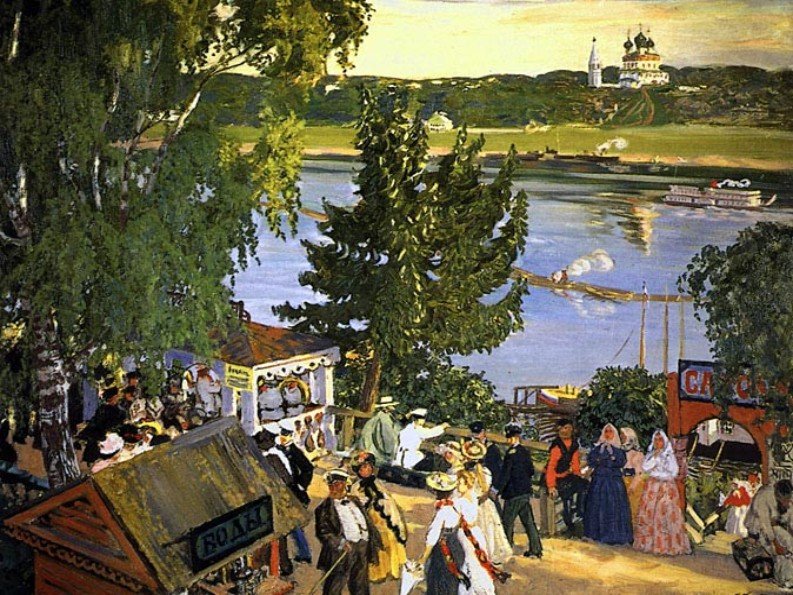 Walking on the Volga, 1909
Walking on the Volga, 1909 Repin invited the young artist to co-author the painting “Meeting of the State Council” (1901–1903, Russian Museum, St. Petersburg). Already in these years, the virtuoso talent of Kustodiev, a portrait painter, manifested itself (I. Ya. Bilibin, 1901). Living in St. Petersburg and Moscow, Kustodiev often traveled to picturesque corners of the Russian province, primarily to the cities and villages of the Upper Volga, where the artist’s brush created famous images of the Russian traditional life(series of “fairs”, “Maslenitsa”, “village holidays”) and colorful folk characters (“merchantwomen”, “merchants”, beauties in the bathhouse - “Russian Venuses”). These series and related paintings (portrait of F. I. Chaliapin, 1922, Russian Museum) are like colorful dreams about old Russia.
 Portrait of Fyodor Chaliapin, 1922, Russian Museum
Portrait of Fyodor Chaliapin, 1922, Russian Museum Although in 1916 paralysis confined the artist to a wheelchair, Kustodiev continued to actively work in different types art, continuing their popular “Volga” series.
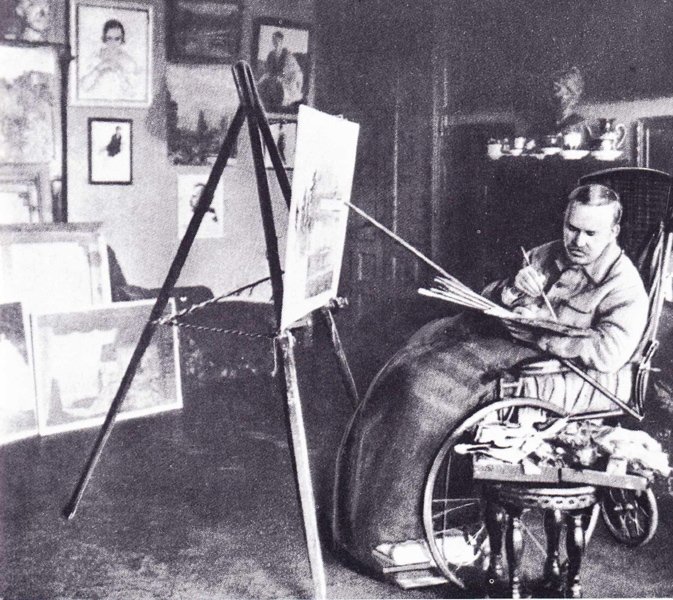 B.M. Kustodiev in his workshop. 1925
B.M. Kustodiev in his workshop. 1925 After the revolution, Kustodiev created his best works in the field of book illustration (“Lady Macbeth of Mtsensk District” by N. S. Leskov; “Rus” by E. I. Zamyatin; both works - 1923; and other drawings) and stage design (“Flea” by Zamyatin in Second Moscow Art Theater, 1925; and other scenery). Boris Mikhailovich Kustodiev died in Leningrad on May 26, 1927.
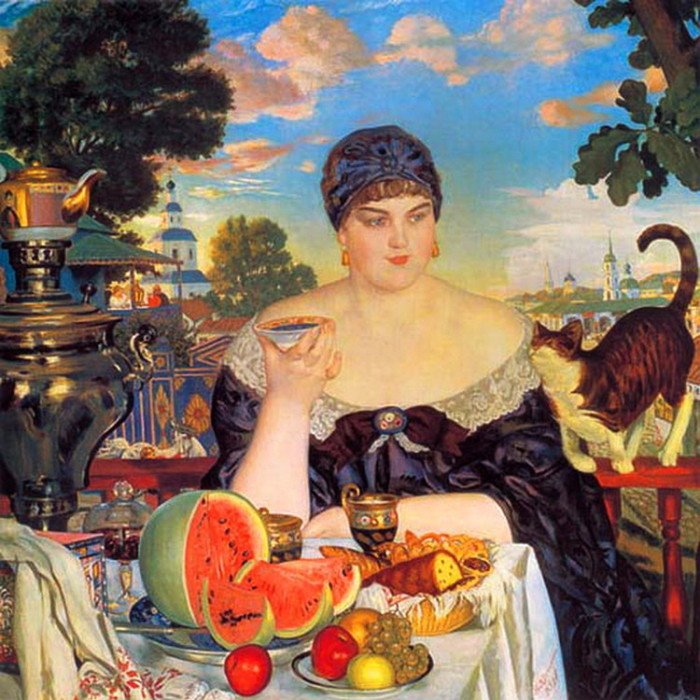 Merchant's wife having tea, 1918 Russian Museum
Merchant's wife having tea, 1918 Russian Museum One of the favorite characters in Kustodiev’s works was a portly, healthy merchant’s wife. The artist painted merchants' bills many times - in the interior and against the backdrop of a landscape, naked and in elegant dresses.
The painting “Merchant's Wife at Tea” is unique in its impressive strength and harmonious integrity. In the plump, immensely fat Russian beauty sitting on the balcony at a table laden with dishes, the image of the merchant’s wife takes on a truly symbolic resonance. The details in the canvas carry a great meaning: a fat lazy cat rubbing against the owner’s shoulder, a merchant couple, drinking tea on the adjacent balcony, a city depicted in the background with churches and shopping arcades and, in particular, a magnificent “gastronomic” still life. A ripe red watermelon with black seeds, a fat muffin, buns, fruit, porcelain, a large samovar - all this is written in an unusually material and tangible way and at the same time not illusory, but deliberately simplified, like on shop signs.
In the hungry year of 1918, in the cold and devastation, the sick artist dreamed of beauty, a full-blooded bright life, and abundance. However, the savoring of a well-fed, thoughtless existence is accompanied here, as in other works by Kustodiev, with light irony and a good-natured grin.
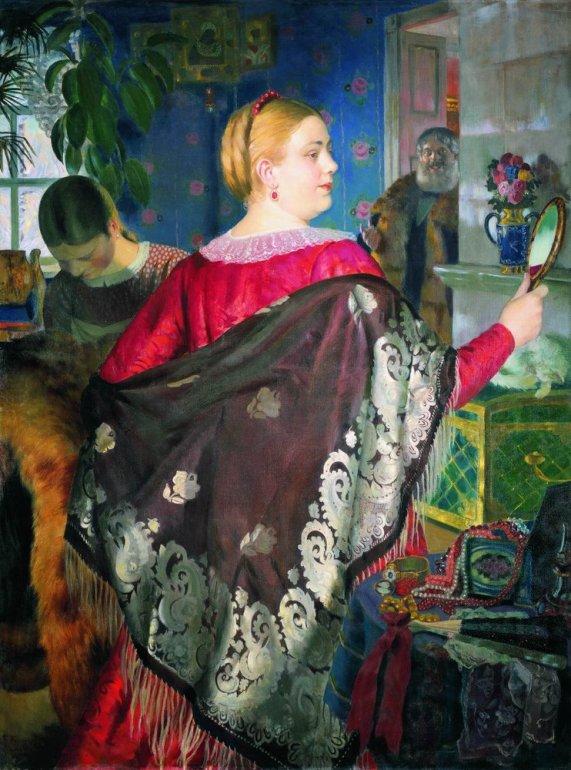 Merchant's wife with a mirror, 1920, Russian Museum
Merchant's wife with a mirror, 1920, Russian Museum Youth always attracts with its brightness, beauty, and freshness. The artist presents us with an ordinary scene from the life of a merchant. A young girl tries on a new silk shawl. The picture is full of details that reveal the character of the heroine. Jewelry is laid out on the table, a girl from the servants is sorting through furs, a green chest by the stove clearly hides the heroine’s “riches.” A smiling merchant in a rich fur coat stands at the door. He admires his daughter, who is captivated by her new wardrobe.
 Beauty, 1915, Tretyakov Gallery
Beauty, 1915, Tretyakov Gallery Kustodiev always drew his inspiration from Russian popular prints. So his famous “Beauty” seems to have been copied from a popular print or from a Dymkovo toy. However, it is known that the artist painted from life, and it is also known that the model was a famous actress of the Art Theater.
The artist approaches the curvaceous forms of his model delicately and with good humor. The beauty herself is not at all embarrassed, she calmly, with some curiosity, watches the viewer, very pleased with the impression she makes. Her pose is chaste. White, curvaceous body, blue eyes, golden hair, blush, scarlet lips - we really have before us beautiful woman.
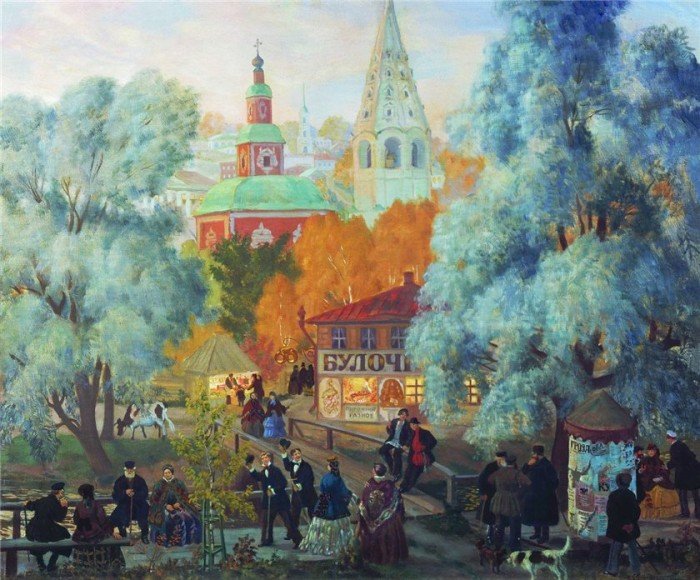 Provinces. 1919
Provinces. 1919 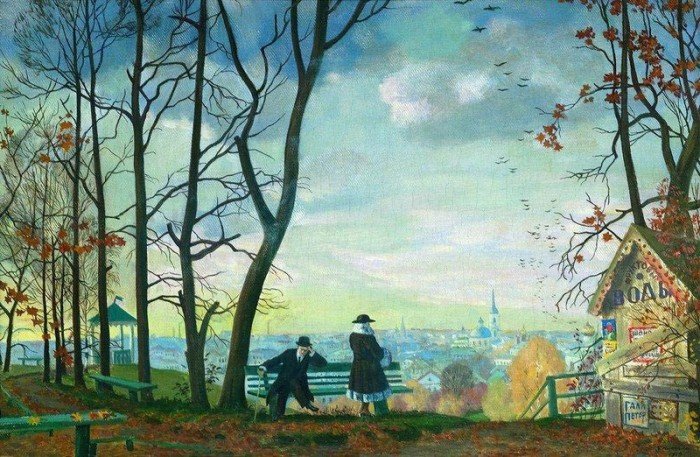 View from the Sparrow Hills. 1919
View from the Sparrow Hills. 1919 The exuberant luxury of colors blooms in lush colors in Kustodiev’s paintings, as soon as he turns to his favorite theme: depicting the foundations of life in the outback, its foundations, its roots. A colorfully depicted tea party in the courtyard cannot but please the eye with all the love of life that reigns in the picture.
Stately backs, proud posture, the obvious slowness of every movement, the conscious sense of self-esteem that is felt in all female figures - this is old Suzdal, the way the artist sees, feels, feels it. And he is all in front of us in full view - alive and bright, real. Warm. He definitely invites you to the table!
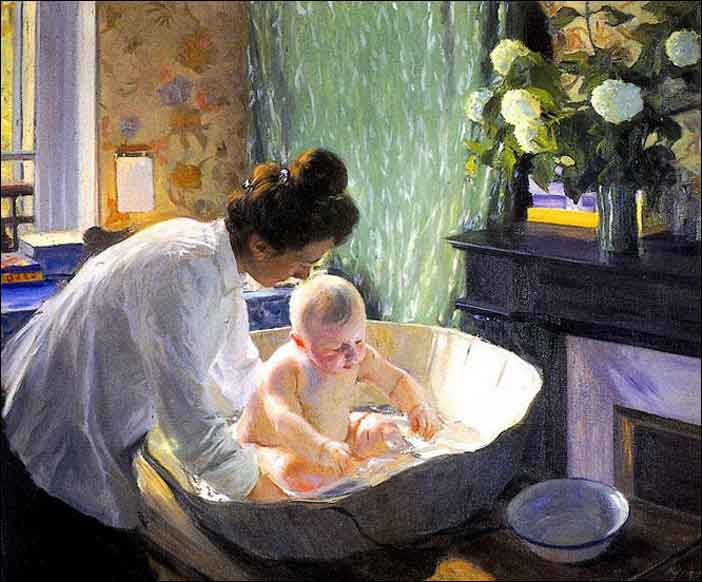 Morning, 1904, State Russian Museum, St. Petersburg
Morning, 1904, State Russian Museum, St. Petersburg Depicted are Yulia Evstafievna Kustodieva, the artist’s wife, with her first-born son Kirill (1903-1971). The picture was painted in Paris.
 Russian Venus, 1925, Nizhny Novgorod Art Museum, Nizhny Novgorod
Russian Venus, 1925, Nizhny Novgorod Art Museum, Nizhny Novgorod  Bathing, 1912, Russian Museum
Bathing, 1912, Russian Museum According to Kustodiev’s style, the sunny day in the painting is filled with rich colors. Blue sky, green hillside, mirror-like shine of water, sunny yellow swimming pool - all together make up a warm summer.
The bathers are depicted by the artist schematically, very delicately. Kustodiev himself seems to take the viewer’s gaze away from the bathhouse and draws attention to the surrounding nature, filling it with unnatural bright colors.
It's coming on the shore usual life. Boatmen offer the public a ride along the river; a loaded cart struggles up the mountain. On the hill there is a red church.
Twice the artist depicted the Russian tricolor. A white, blue and red cloth decorates the bathhouse and the side of a large boat. Most likely, we have a holiday ahead of us. Summer is a holiday for everyone who is able to appreciate it.
The bathers are having a leisurely conversation, enjoying the warmth, sun, and river. Slow, measured, happy life.
 Merchant's wife and brownie, 1922
Merchant's wife and brownie, 1922 The artist depicted a very piquant scene. The brownie, walking around his property, froze in amazement in front of the naked body of the sleeping mistress of the house. But the details still tell the viewer that the heroine of the picture has prepared everything for this scene. The hot stove is left open so that the fire provides light. The pose is carefully thought out. One gets the feeling that the hostess’s dream is theatrical. It’s as if the beauty herself is luring the brownie to look at him. Fairy tale, Christmas story, miracle.
An elegant, fair-haired, dazzlingly beautiful merchant's wife - on the one hand, an eerie, fur-covered, pot-bellied brownie - on the other. They are like the embodiment of merchant female and male beauty. Two different beginnings, opposites.
 Trinity Day, 1920, Saratov State Art Museum. A. N. Radishcheva
Trinity Day, 1920, Saratov State Art Museum. A. N. Radishcheva 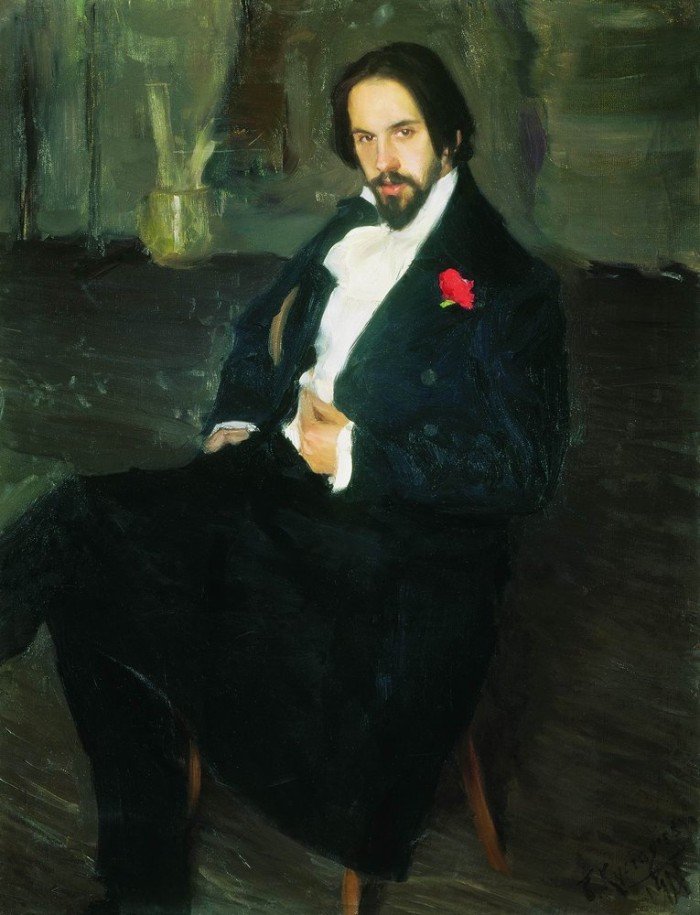 Portrait of the artist Ivan Bilibin, 1901, Russian Museum
Portrait of the artist Ivan Bilibin, 1901, Russian Museum This portrait is an early work of the master. It was created in the academic workshop of I. Repin. In this work, Kustodiev’s style barely shows through. It just hasn't formed yet. Bilibin is depicted very realistically. Before us is an exquisitely dressed young man: a black frock coat, a snow-white shirt. The red flower in the buttonhole is a detail that characterizes the model. The hero is dapper, a lover of women and entertainment. The look is ironic, even funny. The facial features are correct. Before us is a handsome young man.
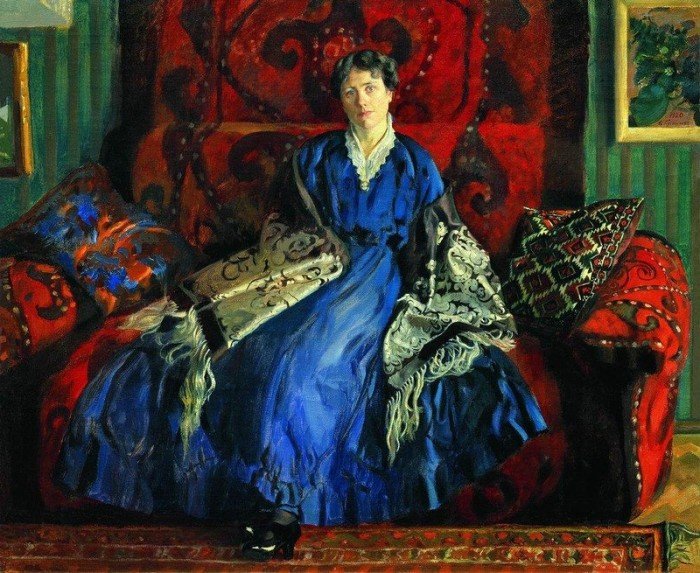 Portrait of Yu.E. Kustodieva. 1920
Portrait of Yu.E. Kustodieva. 1920 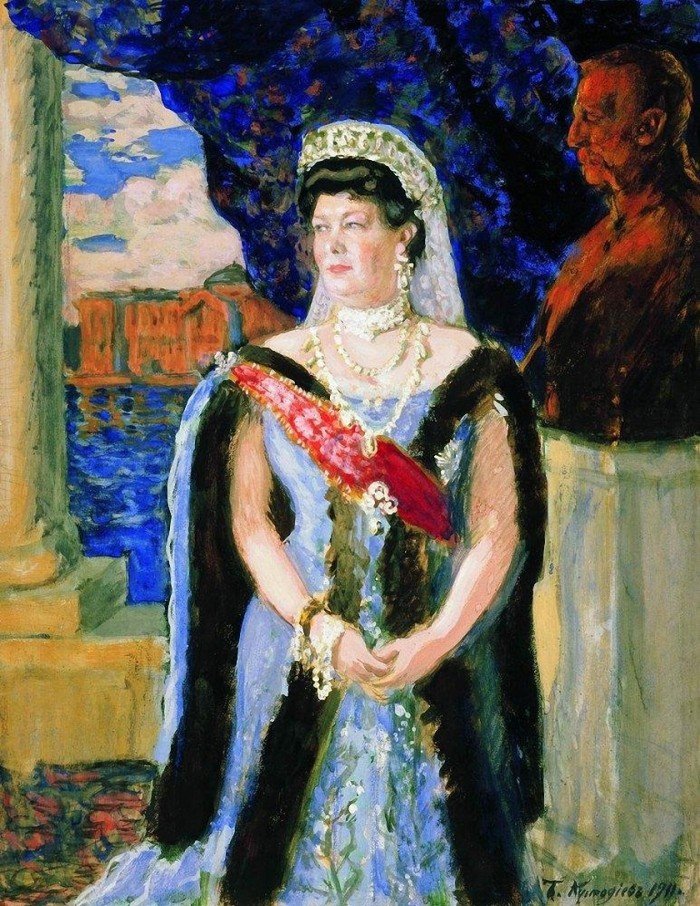 Portrait of Grand Duchess Maria Pavlovna.1911
Portrait of Grand Duchess Maria Pavlovna.1911 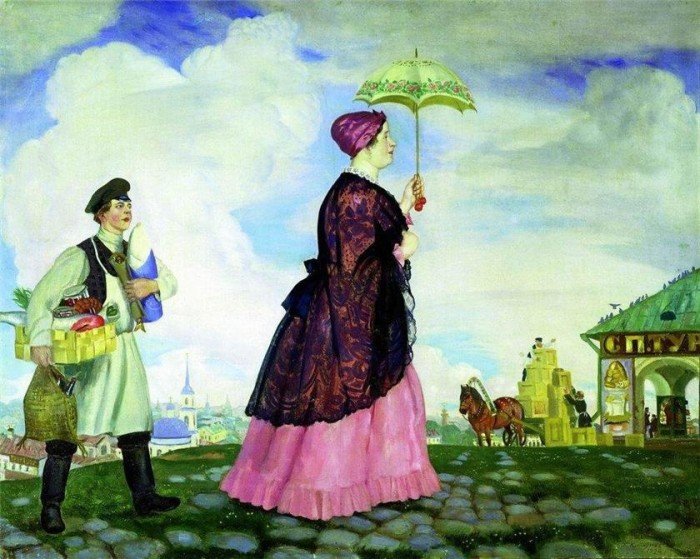 Merchant's wife with purchases.1920
Merchant's wife with purchases.1920  Moscow tavern, 1916, Tretyakov Gallery
Moscow tavern, 1916, Tretyakov Gallery The Moscow tavern is a special, difficult place. The main thing in it is communication and relaxation. This is exactly how the tavern appears in the picture. The sex workers serving visitors are graceful and graceful. Red ceilings and vaults give the work a joyful and festive atmosphere. Judging by the bunch of willow behind the icon, the action takes place on the eve of Easter.
In the center of the tavern, a very colorful group sat at one table. Their identical clothes identify them as cab drivers taking a tea break. The cab drivers sip their tea with decorum and dignity. Like medieval guild masters during a solemn ceremony. A musical accompaniment provided by songbirds in cages under the ceiling. The elder of the respected congregation sits under the icon. One can even discern some similarity between the image on this icon and the stern and solemn face of the chairman of the tea party.
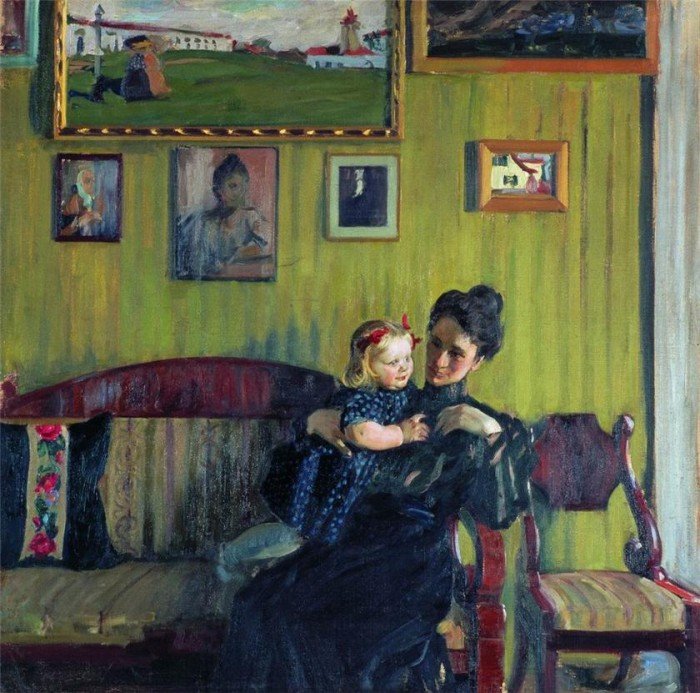 Portrait of Yu.E. Kustodieva with her daughter Irina. 1908, State Museum fine arts Republic of Tatarstan
Portrait of Yu.E. Kustodieva with her daughter Irina. 1908, State Museum fine arts Republic of Tatarstan  Lilac, 1906
Lilac, 1906 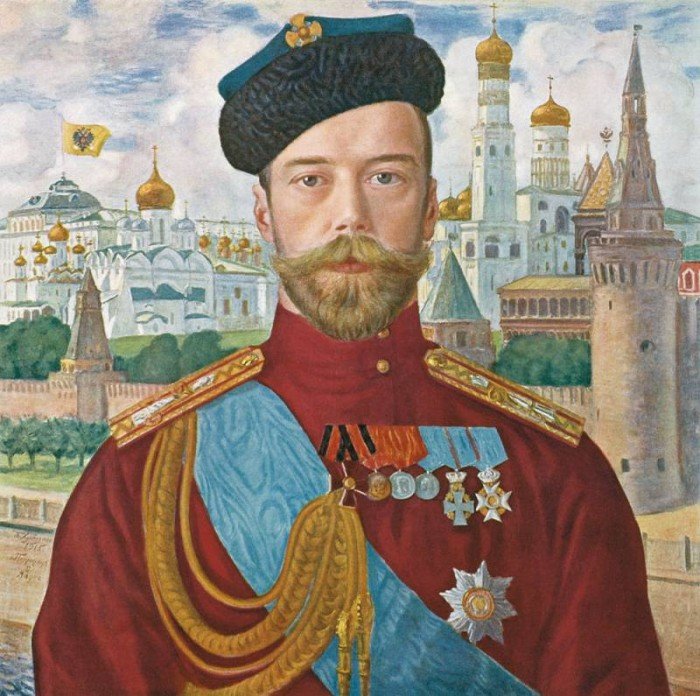 Emperor Nicholas II, 1915
Emperor Nicholas II, 1915 Found a mistake? Select it and press left Ctrl+Enter.
Boris Mikhailovich Kustodiev (February 23 (March 7) 1878, Astrakhan - May 26, 1927, Leningrad) - Russian artist.
Biography of Boris Kustodiev
Boris Mikhailovich Kustodiev, originally from the family of a gymnasium teacher, began studying painting in Astrakhan with P. A. Vlasov in 1893-1896.
Born in 1878. Took drawing lessons from P.A. Vlasov, who graduated from the Moscow School of Painting.
After a two-year stay in the general classes of the Academy of Arts, he entered the workshop of I.E. Repin, whom he helped in painting “Meeting of the State Council” (Kustodiev painted the entire right side of the picture, with sketches for it).
Received a business trip abroad for the film “Village Fair”.
He exhibited his works successively at the “Spring Exhibitions” at the Academy of Arts, at exhibitions of the “New Society”, at exhibitions of the “Union”, at the “Salon”, and since 1910 at exhibitions of the “World of Art”, abroad - in Paris, Vienna , Munich, Budapest, Brussels, Rome, Venice, Malmo and other cities.
Kustodiev's creativity
Kustodiev began his career as a portrait artist. Already while working on sketches for Repin’s “Great Meeting of the State Council on May 7, 1901,” student Kustodiev showed his talent as a portrait painter. In sketches and portrait sketches for this multi-figure composition, he coped with the task of achieving similarities with Repin’s creative style. But Kustodiev the portrait painter was closer to Serov.
Already from the beginning of the 1900s, Boris Mikhailovich was developing a unique genre of portrait, or rather, portrait-picture, portrait-type, in which the model is linked together with the surrounding landscape or interior.
At the same time, this is a generalized image of a person and his unique individuality, revealing it through the world surrounding the model. In their form, these portraits are related to the genre images-types of Kustodiev (“Self-portrait” (1912), portraits of A. I. Anisimov (1915), F. I. Chaliapin (1922)).
Subsequently, Kustodiev gradually shifted more and more towards an ironic stylization of folk and, especially, the life of the Russian merchants with a riot of colors and flesh (“Beauty”, “Russian Venus”, “Merchant’s Wife at Tea”).
Like many artists of the turn of the century, Kustodiev also worked in the theater, transferring his vision of the work to the theater stage.
The scenery performed by Kustodiev was colorful, close to his genre painting, but this was not always perceived as an advantage: creating a bright and convincing world, carried away by its material beauty, the artist sometimes did not coincide with the author’s plan and the director’s reading of the play (“The Death of Pazukhin” by Saltykov- Shchedrin, 1914, Moscow Art Theater; “The Thunderstorm” by Ostrovsky, which never saw the light of day, 1918).
In his later works for the theater, he moves away from a chamber interpretation to a more generalized one, seeks greater simplicity, builds the stage space, giving freedom to the director when constructing mise-en-scenes.
Kustodiev's success was his design work in 1918-20. opera performances (1920, “The Tsar’s Bride”, Bolshoi Opera House People's House; 1918, “The Snow Maiden”, Bolshoi Theater (not staged)). Scenery sketches, costumes and props for A. Serov’s opera “The Power of the Enemy” (Academic (former Mariinsky) Theatre, 1921).
Portrait of professor of engraving V.V.Mate. 1902
We all know Kustodiev from his famous Merchants and Russian beauties in body. But besides the “fair” period, Kustodiev had a wonderful early period (1901-1907). He painted with a “wet” brushstroke, beautifully and selflessly, no worse than Sargent and Zorn. Then many artists painted in a similar manner, Braz, Kulikov, Arkhipov. Kustodiev was better. What made him change his writing style - a reluctance to be one of... or maybe a tragedy and poor health, or a change in worldview that came with a change in society, a revolution... I don’t know. But I especially love this period in Kustodiev’s work.
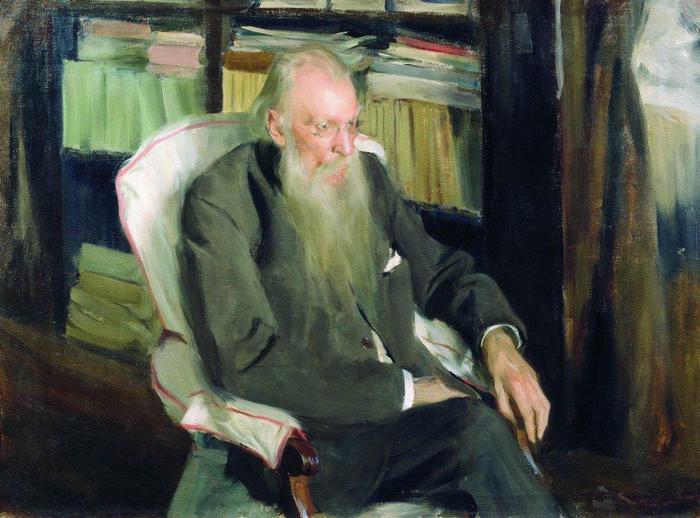
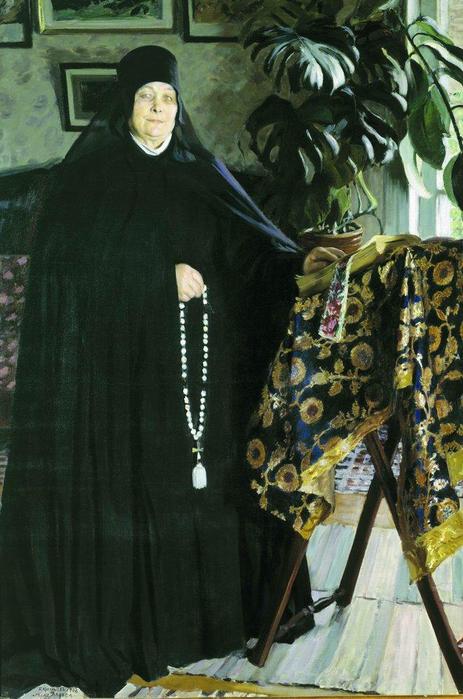
Nun. 1908
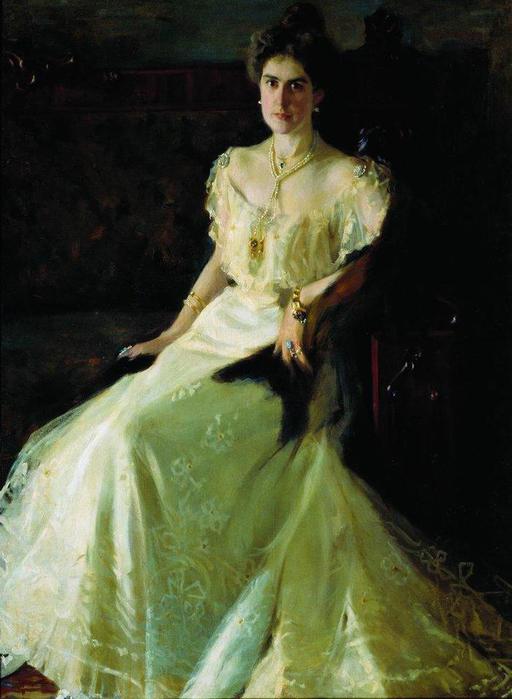
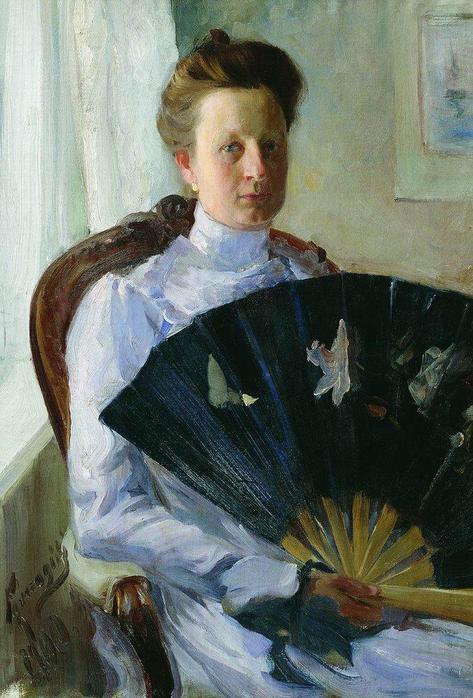


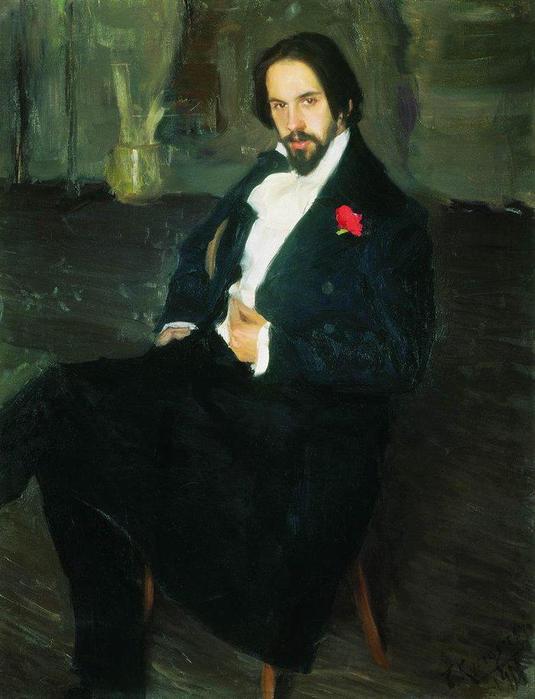
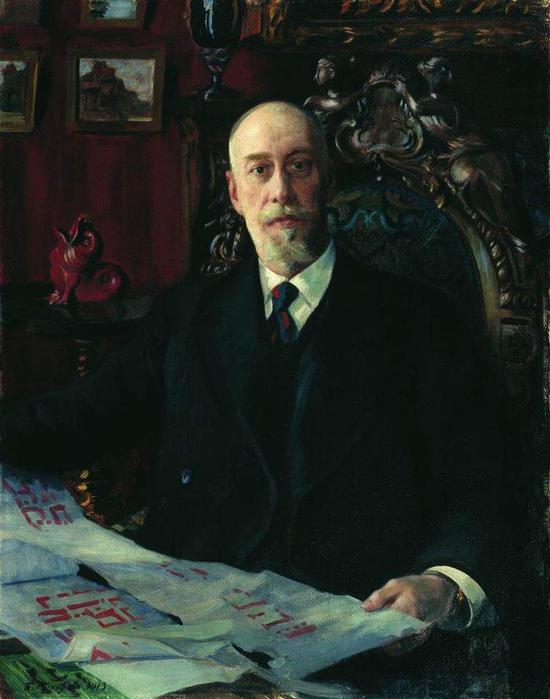
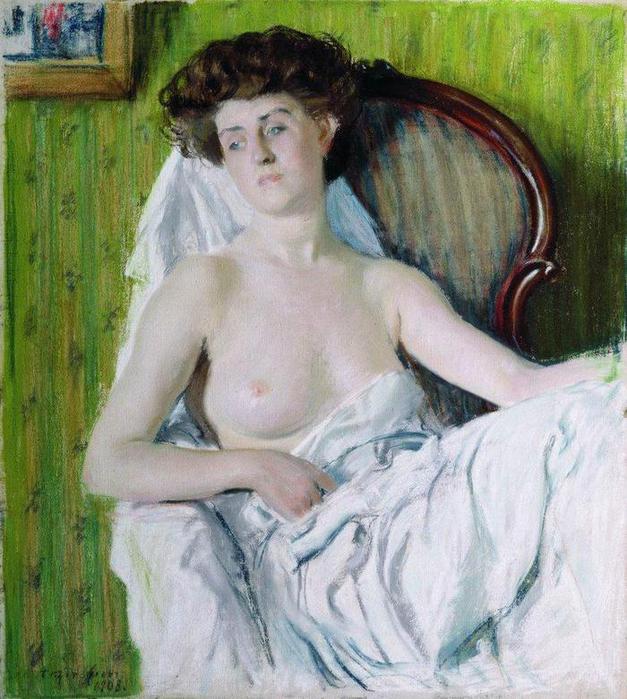

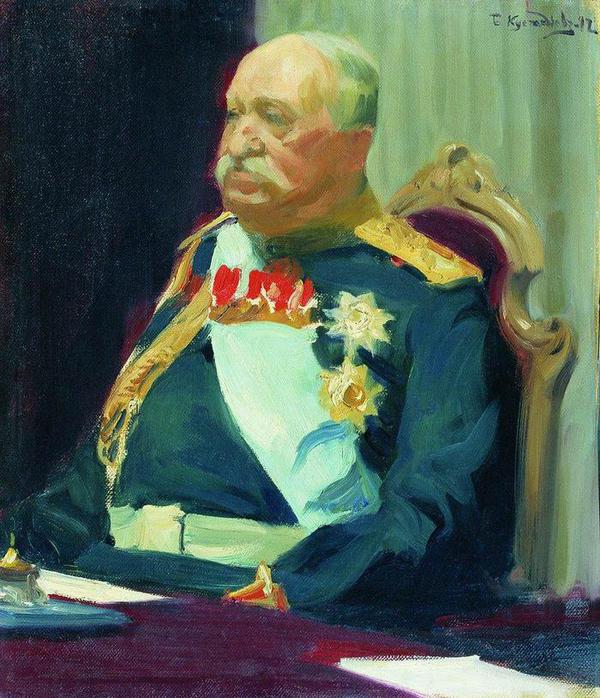
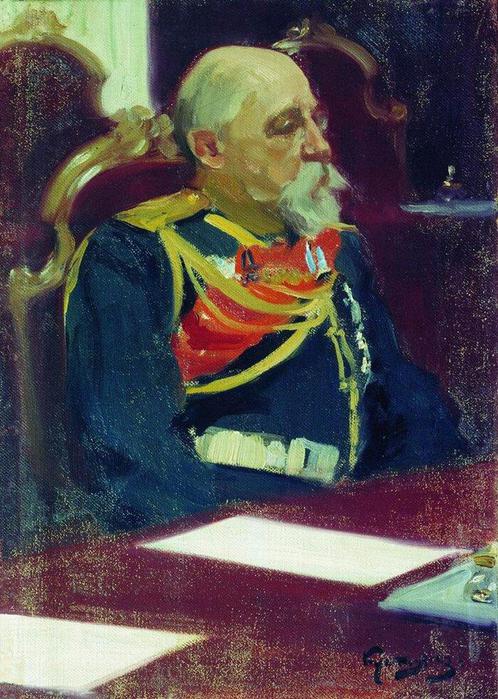
Portrait of the Governor General of Finland N.I. Bobrikov. 1902-1903
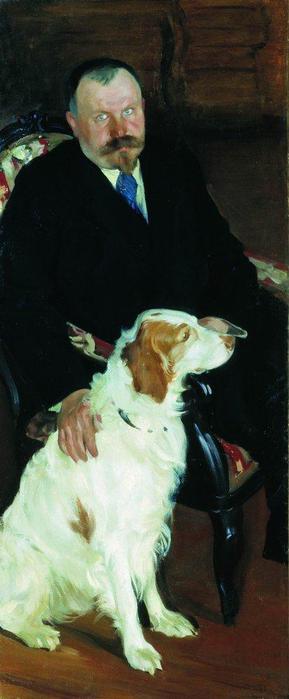

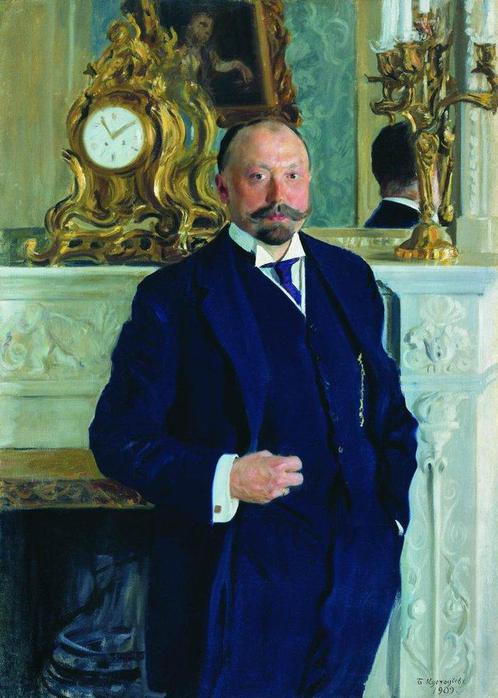
Portrait of P.L. Bark. 1909
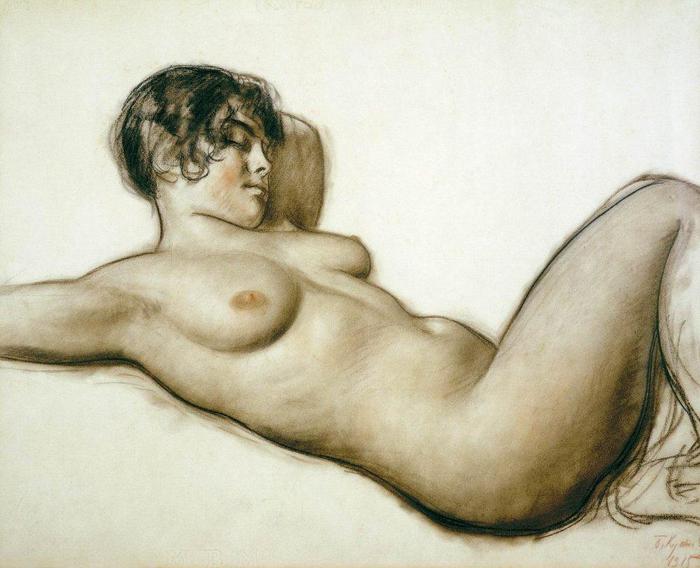
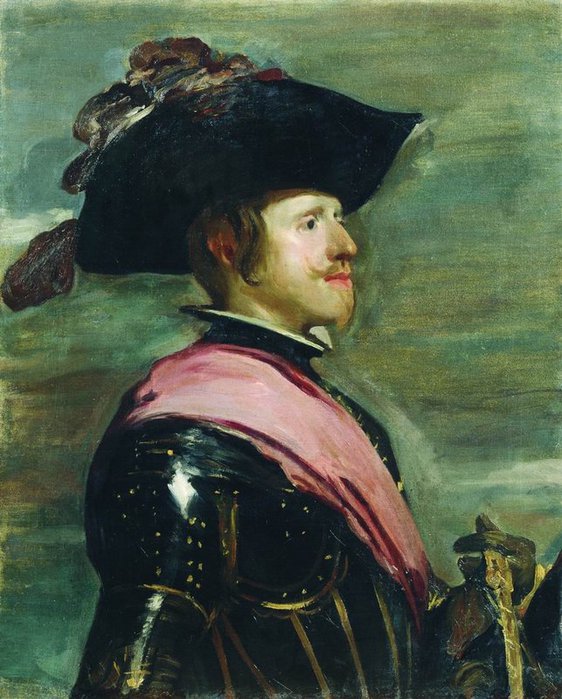
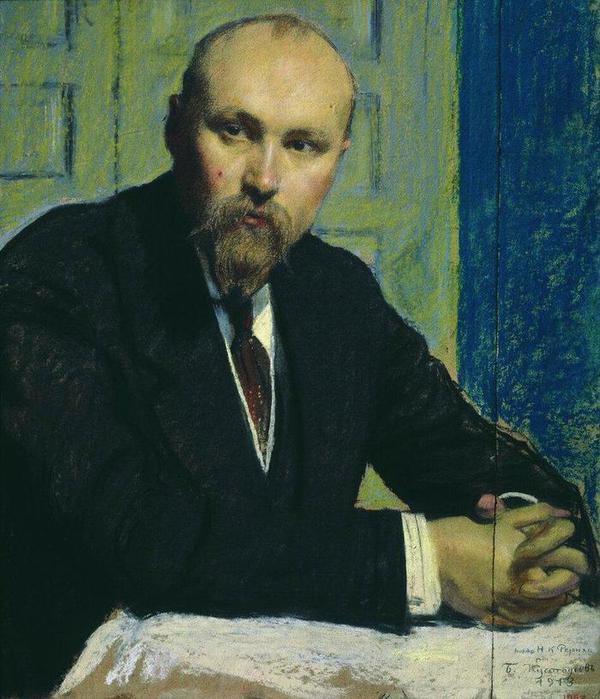




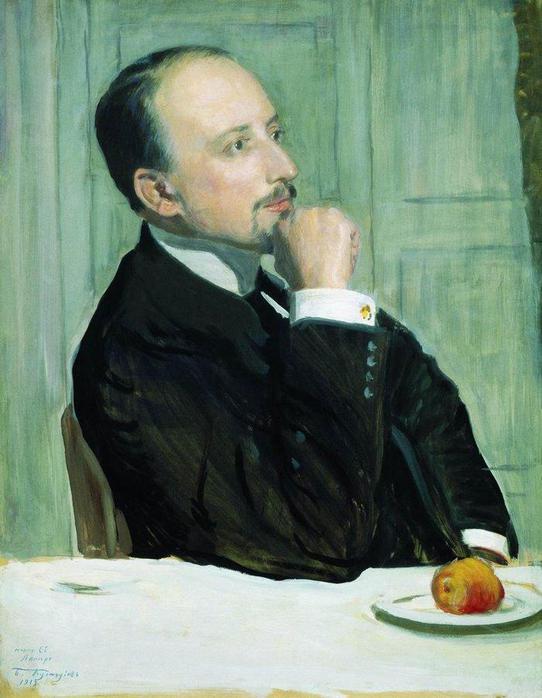



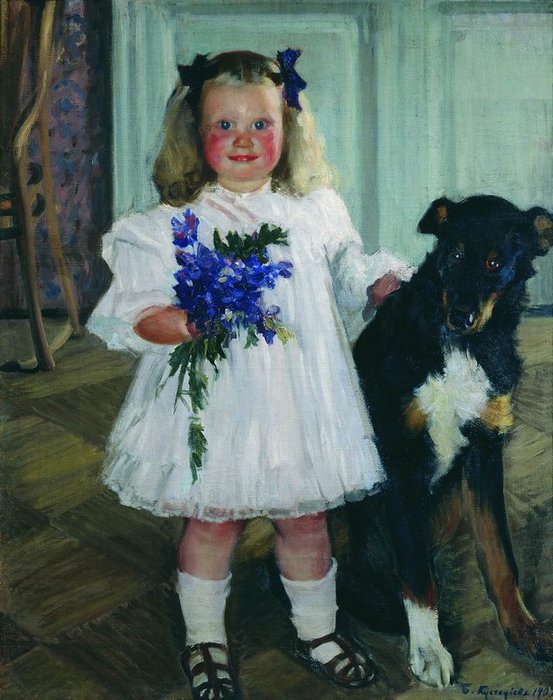
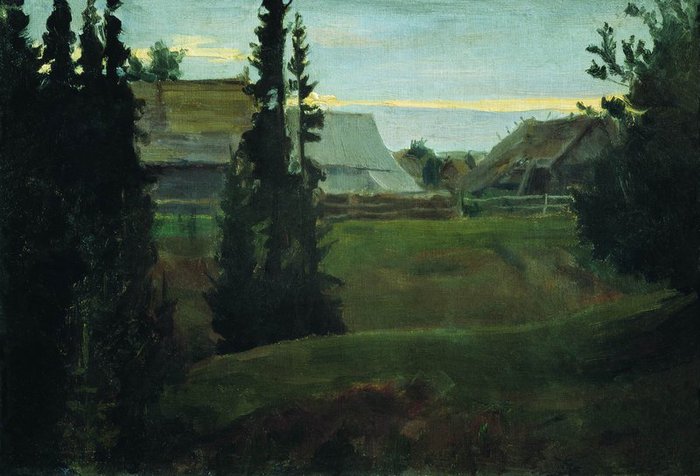


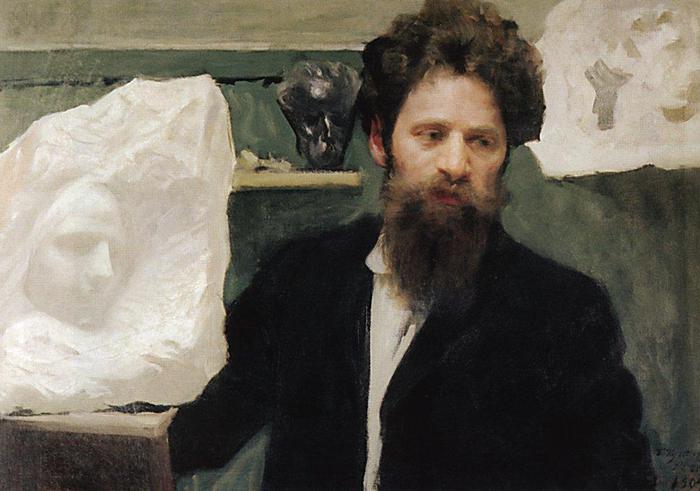


Portrait of Ya.I. Lavrin. 1909
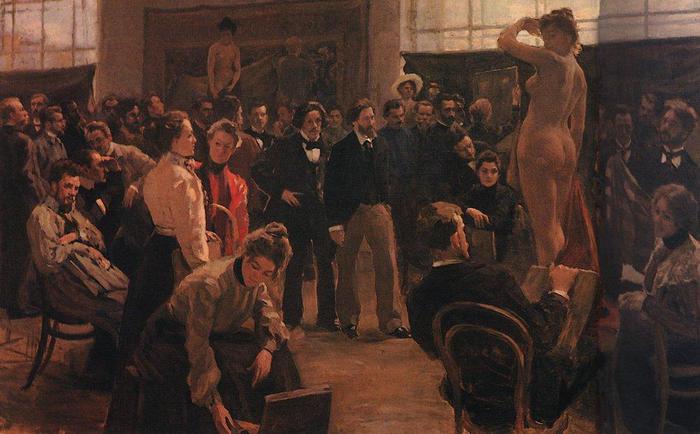

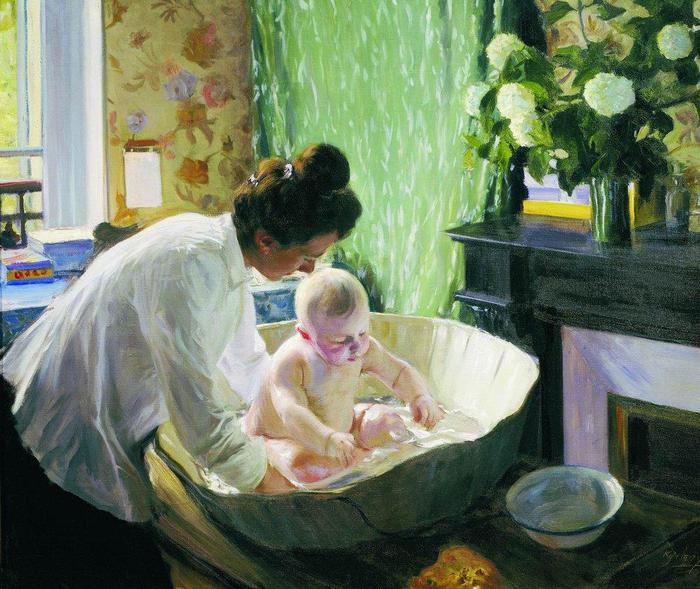

Boris Kustodiev was born on March 7, 1878 in Astrakhan.
In the fall of 1896, Kustodiev entered the school at the Academy of Arts in St. Petersburg. In those years, the fame of both Vasnetsov and Repin was already thundering. Repin drew attention to the talented young man and took him into his workshop. He did not like to talk about his work, but he talked with enthusiasm about his students. He especially singled out Kustodiev and called the young man “a hero of painting.”
According to I. Grabar, “Kustodiev’s portraits stood out against the background of dull academic exhibitions; as the master’s works, they were in the spotlight, the author was invited to all exhibitions, he became famous.” The Italian Ministry of Arts ordered him a self-portrait, which was placed in the hall of self-portraits of artists different eras and countries in the famous Florentine Uffizi Gallery.
Along with portraits, genre paintings by Kustodiev appeared at the exhibitions. One of the main themes is noisy, crowded fairs in his native Volga cities. Kustodiev’s paintings could be read as stories sparkling with humor. After all, diploma work at the academy he did not have a composition on a historical or religious theme, as was customary, but “Bazaar in the Village,” for which he received gold medal and the right to a pensioner's trip abroad. Signs of impending disaster, which abruptly and mercilessly changed Kustodiev's life, appeared in 1909. Suddenly my hand started to hurt, and my fingers couldn’t even hold a light watercolor brush. Terrible headaches began. For several days I had to lie in a darkened room, wrapping my head in a scarf. Any sound increased the suffering. St. Petersburg doctors found he had bone tuberculosis and sent him to the mountains of Switzerland. Shackled from neck to waist in a rigid celluloid corset, torn from his easel and paints, he lay month after month, breathing the healing mountain air of the Alps. The artist later recalled these long months “with a warm feeling, with a feeling of delight at the creative impulse and burning spirit.” Even more surprising is that Kustodiev subsequently “translated” most of the conceived themes and plots onto canvas, into real paintings.
And the disease came. It turned out to be worse than expected: a spinal cord tumor. He underwent a series of difficult operations that lasted several hours. Before one of them, the professor said to his wife:
- The tumor is somewhere closer to the chest. You need to decide what to save, arms or legs?
- Hands, leave your hands! An artist without hands? He won't be able to live!
And the surgeon retained the mobility of his hands. Only hands. Until the end of life. From now on, his “living space” was narrowed to the four walls of a cramped workshop, and the entire world that he could observe was limited to the window frame.
But the more severe Kustodiev’s physical condition was, the more selflessly he worked. During the years of immobility, he created his best things.
The Kustodiev paintings of this period are relatively small in size, on average one meter per meter. But not because it was difficult with the canvas and paints (although this also happened). It’s just that the border of the painting had to be where the brush of the artist chained to the chair could reach.
Here is his “Moscow tavern”. Kustodiev once spied this scene in Moscow and said: “They smelled of something Novgorod, an icon, a fresco.” Old Believers cabbies drink tea fervently, as if saying a prayer, holding saucers on straightened fingers. The dark blue caftans, the thick beards of the men, the white canvas clothes of the floor guards, the dark red, like shimmering background of the walls and the mass of details extracted from memory accurately convey the atmosphere of a Moscow tavern... The son and friends who did not leave the artist posed as cab drivers. The son recalled how, having completed the work, Kustodiev joyfully exclaimed: “But, in my opinion, the picture came out! Well done to your father!” And this is truly one of his best works.
Fyodor Ivanovich Chaliapin decided to stage A. Serov’s opera “The Power of the Enemy” on the stage of the Mariinsky Theater. He really wanted Kustodiev to complete the sketches of the scenery and costumes, and he himself went to negotiations. I saw the artist in a cramped studio, which also served as a bedroom, in a wheelchair, reclining under an easel hanging over him (this is how he now had to work), and “pitying sadness” pierced the heart of the great singer. But only in the first few minutes. Chaliapin recalled: “He amazed me with his spiritual vigor. His cheerful eyes shone brilliantly - they contained the joy of life. With pleasure, he agreed to make scenery and costumes.
- In the meantime, pose for me in this fur coat. Your fur coat is so rich. It's a pleasure to write it..."
The portrait turned out to be huge - more than two meters in height. The majestic, lordly singer of Russia strides widely across the snow crust in a luxurious fur coat. In the picture there was a place for Chaliapin’s family, and even for his beloved dog. Chaliapin liked the portrait so much that he also took sketches for it. In order for Kustodiev to work on such a large painting, his engineer brother secured a block with a load under the ceiling. The canvas with the stretcher was suspended and it was possible to bring it closer, further away, or move it left and right. He painted the portrait in sections, without seeing the whole. Kustodiev said: “Sometimes I myself have a hard time believing that I painted this portrait, I worked so much at random and by touch.” But the calculation turned out to be amazing. The painting, according to the unanimous opinion of critics, has become one of the best achievements of Russian portrait art.
One of Kustodiev’s latest works is “Russian Venus”. Well, how can you believe that this radiant, beautifully drawn naked young woman was created at a time when the artist said: “I am tormented at night by the same nightmare: black cats dig into my back with sharp claws and tear my vertebrae...” And my right arm began to weaken and dry out. There was no canvas for Venus. And he wrote it on the back of some of his old, considered unsuccessful, paintings. The family participated in the creation of the painting. Brother Michael adapted blocks and counterweights for the canvas. The daughter posed, as for many other paintings. Lacking a broom, she had to hold a ruler in her hands. The son whipped foam in a wooden tub so that the image of even this minor detail was close to reality. This is how this one of the most life-loving paintings was born.Before last days Kustodiev worked tirelessly throughout his life. He was busy sketching scenery for the puppet theater for the fairy tale “The Cat, the Fox and the Rooster.” On May 4, I submitted 24 (!) engravings for an exhibition at the State Russian Museum...
Sun. Voinov, a friend of the artist, the author of the first monograph about him, wrote in his diary: “May 15. Kustodiev's name day. He was very sick, but sat in his chair. Gorbunov came to see him.” And in the margin there is a note: “The last time in my life I saw Boris Mikhailovich.” Gorbunov was the manager of the affairs of the Council of People's Commissars of the USSR in those years. He came to inform Kustodiev: the government had allocated money for his treatment abroad. Too late. Boris Mikhailovich Kustodiev died on May 26, 1927.
BIOGRAPHY
Born into a poor family, Boris Mikhailovich Kustodiev (1878-1927) was preparing to become a priest. He studied at a theological school, then at a seminary, but became interested in art, and in 1896, leaving the seminary, he went to St. Petersburg and entered the Academy of Arts (AH). There he studied in the workshop of Ilya Repin and was so successful that the director invited him to be his assistant to work on the painting “Meeting of the State Council.” Kustodiev discovered a gift for portrait painting, and while still a student, he completed a number of first-class portraits - Daniil Lukich Mordovtsev, Ivan Yakovlevich Bilibin (all 1901), Vasily Mate (1902). In 1903, Kustodiev graduated from the Academy of Arts, receiving a gold medal and the right to travel abroad for his diploma painting “Bazaar in a Village” - Kustodiev chose Paris. In Paris, the artist managed to take a closer look at French painting and make good use of his impressions in the beautiful painting “” (1904), but less than six months later he returned to Russia, missing his homeland.
After his return, Kustodiev very successfully tried his hand at book graphics, in particular by illustrating Nikolai Gogol’s “The Overcoat” (1905), as well as in caricature, collaborating in satirical magazines during the first Russian revolution. But the main thing for him still continued to be painting. He performed a number of portraits, among which “” (1909) stood out, as well as “” (1907) and “” (1908), which turned into generalized socio-psychological types. At the same time, he enthusiastically worked on paintings dedicated to depicting old Russian life, mainly provincial. He drew material for them from childhood memories and impressions from his frequent stays in the Volga region, in the Kineshma district, where in 1905 he built a house-workshop. He unfolded fascinating stories, full of entertaining details, in multi-figure compositions "" (1906, 1908), "Village Holiday" (1910) and recreated characteristic Russian female types in the paintings "Merchant's Wife", "Girl on the Volga", "" (all 1915 ), colored with admiration and the author's soft irony. His painting became more and more colorful, approaching folk art. The result was “” (1916) - an idyllic panorama of a holiday in a Russian provincial town. Kustodiev worked on this cheerful picture in extremely difficult conditions: as a result of a serious illness, he was confined to a wheelchair since 1916 and was tormented by frequent pain.
Despite this, the last decade of his life turned out to be unusually productive. He painted two large paintings depicting the holiday in honor of the opening of the Second Congress of the Communist International, performed many graphic and pictorial portraits, made sketches of the festive decorations of Petrograd, drawings and covers for books and magazines of various contents, made wall pictures and calendar “walls”, designed 11 theatrical performances. Often these were custom jobs that were not very interesting to him, but he performed everything at a serious professional level, and sometimes achieved outstanding results. Lithographic illustrations in the collection “Six Poems of Nekrasov” (1922), drawings for Nikolai Leskov’s stories “The Darner” (1922) and “Lady Macbeth of Mtsensk” (1923) became the pride of Russian book graphics, and among the performances he designed, Evgeniy’s “The Flea” shone Zamyatin, staged by the 2nd Moscow Art Theater in 1925 and immediately repeated by the Leningrad Bolshoi Drama Theater.
Kustodiev managed to devote time to the innermost, continuing with nostalgic love to recreate the life of old Russia in a variety of paintings, watercolors, and drawings. He varied the themes of Maslenitsa in different ways in the paintings “” (1917), “” (1919), “Winter. Maslenitsa festivities" (1921) and even in his wonderful portrait of Fyodor Chaliapin he used the same festivities as the background. He depicted the quiet life of the province in “The Blue House”, “Autumn”, “Trinity Day” (all 1920). In the paintings "" (1918), "" (1920), "" (1925-26) he continued the gallery of female types begun in the long-standing "Merchant's Wife". He completed a series of 20 watercolors “Russian Types” (1920) and resurrected his own childhood with maximum authenticity in a number of paintings, as well as in the series “Autobiographical Drawings” (1923) - similar to sketches.
Kustodiev’s energy and love of life were amazing. He, in his wheelchair, attended premieres in theaters and even performed long trips around the country. The disease progressed, and in recent years the artist was forced to work on a canvas suspended above him almost horizontally and so close that he was unable to see the whole thing. But his physical strength was exhausted: an insignificant cold led to pneumonia, which his heart could no longer cope with. Kustodiev was not even fifty years old when he died.
A detailed chronology of Kustodiev’s life and work can be found in the section.
Kustodiev Boris Mikhailovich (1878-1927)
He comes from the family of a seminary teacher. For his development as an artist, the lessons of I. E. Repin at the St. Petersburg Academy of Arts, where he studied in 1896-1903, were of greatest importance. He was a member of the World of Art and the Union of Russian Artists associations.
First experiments
Repin made the young master one of the co-authors of his painting “Meeting of the State Council” (1901-03, Russian Museum). The collaboration resulted in real rivalry, since Kustodiev, demonstrating the early maturity of his talent, created surprisingly lively impressionistic portrait sketches, almost indistinguishable from Repin’s. He demonstrated his remarkable skill as a portraitist in his independent portrait paintings of the beginning of the century, elegant and expressive (“I. Ya. Bilibin”, 1901, ibid.; “The Polenov Family”, 1905, Historical and Art Museum, Vienna). Later (from 1908) he enthusiastically worked in sculptural (also impressionistic in style) portraits, creating - in plasticine, plaster, which were then often converted into marble - a whole gallery of portrait busts of famous cultural figures (M. V. Dobuzhinsky, V. E. Meyerhold, A. M. Remizov, F. Sologub, etc.).Kustodiev’s early interest in national life and history was by no means combined with conservative conservationism. In his political sympathies, he was a liberal, sympathetic to the revolution, which was especially clearly and evilly manifested in his anti-government cartoons of 1905-06.
Russian province in Kustodiev’s paintings
He lived mainly in St. Petersburg and Moscow, constantly visiting picturesque corners of the Russian province. The artist was always especially impressed by the cities and villages of the Upper Volga - Kostroma, Kineshma, Romanov-Borisoglebsk (Tutaev), Nizhny Novgorod, etc. His famous images of peasant, bourgeois, merchant life, “fairs”, “Maslenitsa”, “villages” were born here. holidays”, which developed into large series of oil paintings, gouaches and watercolors, where the artist repeatedly varied the original motif - with an invariably colorful, variegated, major effect, coloristically close to folk art. The master also writes genre portraits-types, where the figures appear as personifications of the Russian province as such (“Merchant’s Wife”, 1915; “Merchant’s Wife at Tea”, 1918; both - Russian Museum), surrounds the portrait characters themselves with a living genre-landscape environment (“F . I. Shalyapin", 1922, ibid.).
Over the years, an ironic-theatrical element grows in his compositions, and a general feeling of idyllic, or slightly sad and nostalgic, unreality grows stronger (“all my paintings are a complete illusion,” the master himself said). Therefore, scenography as such (design of “The Flea” by E. I. Zamyatin at the 2nd Moscow Art Theater, 1925, and other performances, including plays based on A. N. Ostrovsky) appears as a natural continuation of his easel works. A serious illness confined Kustodiev to a wheelchair since 1916, but he continued to work extremely actively and originally. Motifs of joyful renewal dominate in his paintings with a new, revolutionary theme (“Bolshevik”, 1920, Tretyakov Gallery; “Celebration of the Second Congress of the Comintern on Uritsky Square”, 1921, Russian Museum). He creates propaganda graphics in the spirit of popular popular prints, often acts as a book artist, summarizing his old Russian iconography in the book “Rus” (with text by E. I. Zamyatin; 1923) and other cycles, and continues to work as a sculptor (models for porcelain figurines ). The erotic notes characteristic of a number of his images, good-natured (“Russian Venus”, Nizhny Novgorod State Art Museum, 1924-26) or more dramatic (“Merchant’s Wife and the Brownie”, 1922, private collection, St. Petersburg), reach extreme frankness in unpublished drawings to “Lady Macbeth of Mtsensk District” by N. S. Leskov [private collection, Moscow; the published illustrations (1923) constitute one of the artist’s most interesting and striking book cycles].
6 Description of the painting “Maslenitsa” — Kustodiev Boris Mikhailovich 25.01.2016 09:44
Description of the painting by Boris Kustodiev: Maslenitsa.
The painting “Maslenitsa” was painted in the Art Nouveau style by the Russian artist B.M. Kustodiev. in 1916 All the actions in the picture take place on the main square of the provincial town. In the foreground of the picture you can see people riding in a painted sleigh drawn by a pair of festively decorated horses with bells and an arc with bells.
On the cheeks of people, rosy from the frost, there are smiles, joy, laughter. Trade merchants are located nearby and townspeople are visible walking by. The driver can barely hold back the three horses. You can see happy kids riding down the slides, snowballs flying from the boys' fight. Below is a hectic carousel, a noisy fair and crowds of people, either walking, shopping, or watching a performance. Several more sleighs are also visible, conveying the massiveness of the festive fun.
The colorful winter landscape serves as an excellent background for the painting. The artist used an amazing palette of colors: turquoise, blue, gold and red. A parade of bright colors: pink and gold clouds perched on an emerald green sky; the snow shimmers with delicate blue, pink and pale lilac colors. Red and green patterns are used for the shades of the sleigh.
The church, surrounded by trees, is painted with light colors. These colors were not chosen by chance; they radiate the transmission of attitudes towards justice and faith, because White color- a sign of kindness and purity. Bright sun equipped with contrasts, it stands out against the background of a blanket of snow. The snow sparkles in the sun, and the frost falls in flakes from the trees, and the amount of it in the picture makes it look elegant in winter.
Looking at the picture, you get the feeling of being at this festive festivities. It conveys the impressive warmth of this holiday. She is very optimistic and fully conveys the moments of Maslenitsa festivities.
4 Description of the artwork “Zemstvo school in Moscow Rus'” — Kustodiev Boris Mikhailovich 25.01.2016 09:47
Description of the painting by Boris Kustodiev: Zemstvo school in Moscow Rus'.
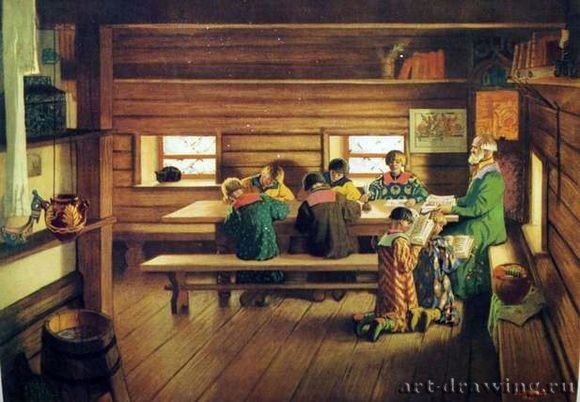
Many historians are sure that it was no coincidence that Kustodiev was interested in the history of Rus'.
In many of his canvases, he recreates not only folk life, but also the special character of people of bygone eras.
We see an ordinary zemstvo school, which was completely common for that time. Seven boys are studying hard. Five of them learn to write with traditional pens. They are extremely focused and completely immersed in this important activity. We feel that they are trying to do the task very well.
Two more boys are depicted in front of the teacher. They are kneeling and reading a book. It becomes clear that not all students study so diligently. Some people simply need to be forced to do it. Probably these two brats are being punished in this way for some offense they committed. On the right we see the teacher. He is strict and very serious. The viewer can feel that this person is truly proud of his profession.
There is a book on the teacher's desk. But she doesn't attract his attention at all. All his attention is absorbed in what his students are doing. Created full impression, that Kustodiev portrays a teacher who not only punishes students for pranks, but also praises them for obvious successes.
Zemstvo schools were especially valuable for the people, since the children of ordinary people could receive an education in them. The artist depicts a school in which the atmosphere is strict, but at the same time cozy. We see wooden furniture and various simple utensils. Most likely, this is just a room in a hut. But everything exudes incredible warmth. It is very important.
Kustodiev portrays special cleanliness at school. The floor here, although unpainted, is polished to a perfect shine. The windows are perfectly clean. The light of the sun not only penetrates them, but flows in a special way.
The painting is dominated by brown and green tones. He manages to create a truly cheerful canvas. Kustodiev seems to be telling us that education is very important in our lives. It is worth approaching it with maximum responsibility at all times.
6 Description of the painting “Lilac” — Kustodiev Boris Mikhailovich 25.01.2016 09:51
Description of the painting by Boris Kustodiev: Lilac.
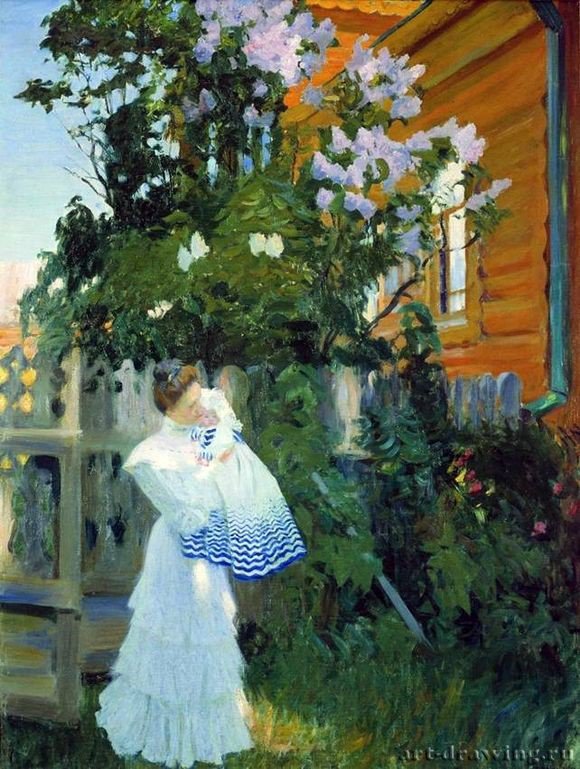
The paintings of the artist Boris Kustodiev are not difficult to recognize by his unique style of execution. When working, he used soft but bright colors and whitewash, as a result of which his canvases were remembered with a specific color scheme and unusual compositional techniques.
Kustodiev was very fond of depicting simple and bright scenes from human life: everyday work, folk holidays or just fine days. Often in his paintings the author described real moments from his own life. The canvas called “Lilac” is one of them.
A picture of a clear day at the end of spring opens before the viewer’s gaze. Sun rays generously gift the earth, warming and illuminating everything around. Lush green grass, wooden house and hedge, as well as spreading tall bush lilacs fill the air with unique, pure aromas that only exist in villages. Judging by the blooming curly lilac flowers, it is clear that the action takes place in early May.
A beautiful young woman comes out of the slightly open gate, holding her little daughter in her arms. This wonderful day is the perfect time to take your child for a walk in nature. A snow-white dress with a full skirt, collar and sleeves gives her image sublimity and grace. The woman's thick brown hair is pulled up into a neat bun.
The baby, who is in her mother’s arms, is also dressed in a fluffy light dress with blue stripes. A white cap protects her head from the sometimes hot rays of the spring sun.
Family was a great happiness in the life of the artist Kustodiev. On this canvas, in 1906, he depicted his beloved wife Julia along with their little daughter. This is probably why so many touching emotions are put into the picture. Feelings of tenderness, care and warmth certainly begin to be transmitted to the viewer looking at the picture.
5 Description of the artwork “After the storm” — Kustodiev Boris Mikhailovich 25.01.2016 09:52
Description of the painting by Boris Kustodiev: After the thunderstorm.
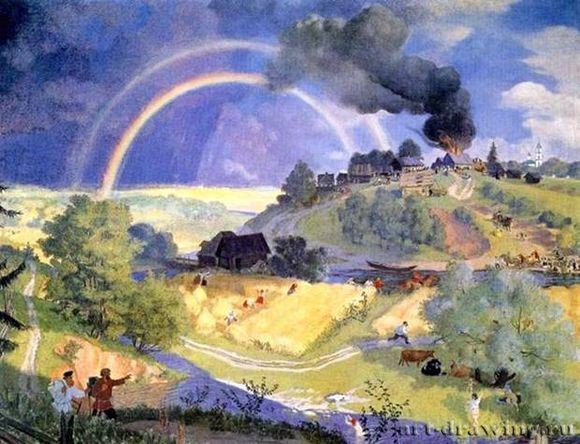
B. Kustodiev painted the painting “After the Storm” in 1921. Times were difficult in Russia, the revolution and Civil War exhausted the people. The painting reflects the beauty and harmony of peaceful life. It contains harmony, tragedy, and hope.
The canvas depicts the outskirts of a Russian village. On the hill one can see wooden houses. The typical location of a settlement: on one side there is a forest, and below there is a river. Several storylines intertwine in the picture. So in life, many events happen at the same time.
In the foreground, two men in Russian blouses are walking along the road. One points towards the stream where women are bathing. One can assume that the men are going to pick mushrooms, but the smart shirts and important headdress of one of them indicate that the men went to the city or passed by the village. A large stream flows out of a wide river, where women bathe.
In the distance you can make out naked female figures. This picture is very attractive to men. Cows are resting under a tree next to the women. They graze on a hot summer day and hide from the sun at lunchtime. For the modest wooden houses the crown of the temple is visible.
The artist conveys the spirituality of the Russian people. Even in a small village there is always a church. If you take a quick look at the picture, you may not immediately notice the main event of that hot day. One of the village houses is on fire. Black smoke billows over the roof and can be seen from a great distance. Maybe the passing man in the foreground was pointing his hand not at the undressed woman, but at the burning house. Many people run to the fire. So the cow herder hurries towards the burning house, and the family moves in a hurry across the wheat field.
A fire on such a hot day can spread to the entire village, so everyone wants to put out the flames. A rainbow is visible above the village as a symbol of hope that everything will be fine. The sky after the thunderstorm is clear and the dark clouds are gone, but it is the rain that local residents need so much now. The house may have caught fire from a lightning strike.
6 Description of the painting “Thunderstorm” — Kustodiev Boris Mikhailovich 25.01.2016 10:42
Description of the painting by Boris Kustodiev: Thunderstorm.
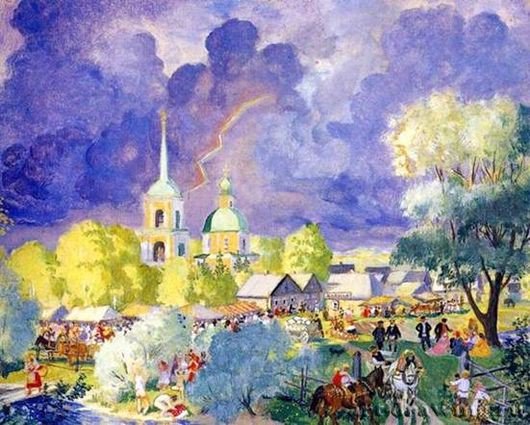
For the last decade and a half of his life, Kustodiev was a wheelchair user.
This happened after an illness and serious surgery on the spinal cord. Partly because he was tormented by constant pain in life, his paintings always depicted the brighter side of life.
Something similar can be seen in the painting “Thunderstorm”. An ordinary village or a small provincial town. A church with golden domes, people minding their own business. Kustodiev was the creator of a new genre - the portrait-painting, a combination of the classical portrait famous person with a popular print. This painting is a portrait of everyday life.
The canvas is as detailed as possible. Every little detail is spelled out. Most people pass by such little things in life and do not pay attention to them. Bathers in polka dot dresses, a woman running across the river with a basket, a young girl washing clothes, an old woman proving something to her husband near a rickety fence. Judging by the standing train and numerous trade counters, you can guess that the fair has just ended here, heading to other cities.
The picture is almost a typical popular print: a quiet village, people, a temple, respectable houses, a fair. The only thing that stands out from the external gloss is lightning, broken, multi-colored, striking the dome of the church - after all, the initially high spire is precisely a lightning rod. But the artist was able to include even this in the popular print: lightning strikes the temple, moves away from it and does not reach the people. No one pays attention to her, and everyone continues to go about their business.
“Thunderstorm” was made in the traditional Kustodiev technique. He painted in oils and pastels. Oil was used to depict the sky. Everything that is written below - the church, houses, trees - is slightly muted with pastels. This painting - good combination Russian character with modernity and even impressionism.
7 Description of the painting “Spring” — Kustodiev Boris Mikhailovich 25.01.2016 09:54
Description of the painting by Boris Kustodiev: Spring.
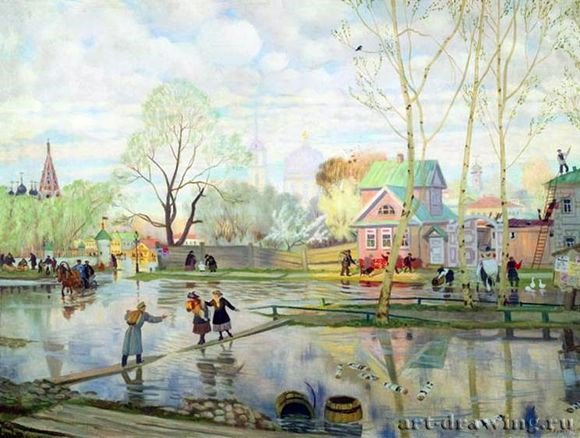
In 1921, the Russian artist Kustodiev was already bedridden due to a serious illness. But the canvas “Spring” he painted during this period looks like a real hymn to cheerfulness. Light, pastel, seemingly sweet and sugar-powdered houses, sky and earth, people and animals - everything in the picture is the personification of some sweet childhood dream.
The artist wrote “Spring” as a symbol of a new birth, awakening and resurrection of nature and all life. The plot of the picture is filled with events. Cotton clouds float across the soft blue sky, reflected in the moving stream of melt water. A man on a wooden beam offers help to two confused ladies in the middle of a flooded section of the street.
On the right side of the picture, peasant everyday life is in full swing: a woman is rolling a barrel, a guy is herding geese, pecking chickens are visible in the open gate of the yard, two more men are working on the roof, children are frolicking, old man with the dog he goes about his business.
On the left, trade is in full swing; a coachman is transporting a passenger across the formed shallow river. Against the backdrop of all this activity, the domes of churches can be seen as if in a foggy haze. The plant kingdom throughout the picture is diluted with animal life. Even on the branch of a tall birch tree, Kustodiev did not forget to place a lonely bird.
In “Spring” everything moves, blooms and sings. You look at it and feel the fresh frosty spring breeze, hear the hubbub of people and the voices of animals. And all this is so harmonious, coherent, as if one great Russian soul is described here.
“Spring” gives the viewer a feeling of joyful awakening. The artist worked on the canvas from memory, and looking at the result of his painstaking work, you understand how impressed he was once by the first spring floods, nature and Slavic people that reality is conveyed with such love and accuracy.
5 Description of the painting “Morning” — Kustodiev Boris Mikhailovich 25.01.2016 09:56
Description of the painting by Boris Kustodiev: Morning.
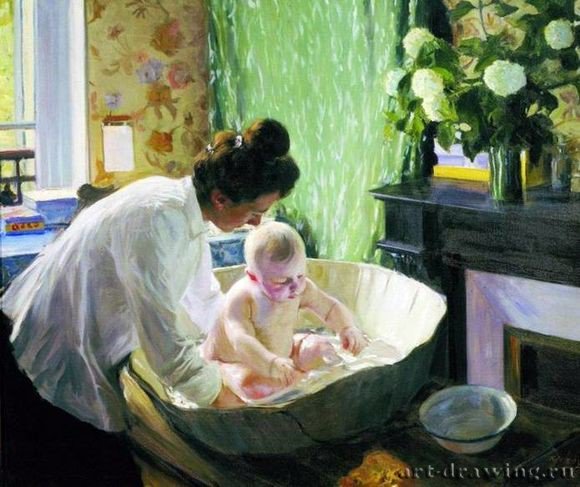
The painting depicts the Kustodiev family - his wife and first-born. Early in the morning, the mother brought the child into the room to bathe her. Sunlight pours in from the window, illuminating a table cluttered with things, a fireplace that is not burning due to the warmth, a vase with white chrysanthemums on it, a small basin.
The mother is dressed in a light white blouse and a black skirt. Her hair is pinned high so that the child, splashing, does not wet it. She bends low towards the bath and scoops it into her palms. clear water to water the baby. He is plump, pink-cheeked, with short blond hair, also reaching for the water, as if trying to repeat his mother’s gesture. He has folds of fat at his wrists, pink knees, and he looks very concentrated, as if the success of the entire enterprise depends on his help.
The picture exudes warmth and comfort. The apartment is not furnished too richly, but with taste and love. The woman is not very beautiful, but the way she bathes her son shows great care and attention. The baby is not much different from any other baby, but it is painted with love and accuracy, as if the artist had set himself the task of transferring his son onto the canvas as accurately as possible.
This is a small idyll of a family, expressed in everyday little things. The way a baby clings to its mother's hand when it first tries to walk. In the way his mother reads him a bedtime story and returns the bright rattle he threw away. In the way she teaches him to play, teaches him to count, teaches him to be a real person.
These actions are the same for everyone, but in each family they are played out in their own way. Just as in theaters, where one troupe’s hero is fat, another’s is lame, a third’s forgets the text, and a fourth’s suffers from shortness of breath, so in a family the actions are colored according to the one who plays them.
And if they are played by a loving family, they are strikingly different from those played where there is no love.
7 Description of the painting “Russian Venus” — Kustodiev Boris Mikhailovich 25.01.2016 09:57
Description of the painting by Boris Kustodiev: Russian Venus.
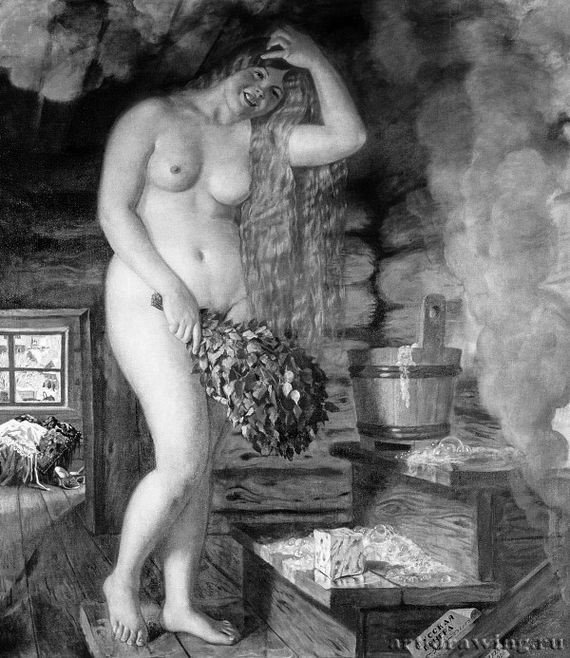
This is the last large painting by the great Russian artist. Written by him in Last year life, when Kustodiev was already almost completely affected by his serious illness. Experiencing severe pain caused by spinal tuberculosis, Kustodiev tried to depict a collective image of a Russian village beauty in his painting. A plump young lady, sparkling with health, shine, and the purity of freshly washed skin. Her golden hair cascades down one side. A sincere, lively smile and cornflower blue, beautiful eyes.
It is important to pay attention to the environment in which the girl is. This is an ordinary village bathhouse, of which there are thousands throughout Russia. The girl is a true Venus, as soap bubbles are visible at her feet, and as is known according to legend, Venus arose from the foam of the Mediterranean Sea, and in Russia from the soap foam of a hot bath.
The image of the Russian Venus, in Kustodiev’s view, is personified in a healthy girl, in the prime of life, strong, in the magnificent body of a village woman. Capable of creating a strong family and giving birth to healthy children.
Kustodiev was attracted to subtle women with a lively mind, such as the artist’s wife. But most often in his paintings the author liked to depict plump women. He portrayed them with some tenderness, and sometimes even mockery.
Elena Nikolaeva, a young village girl, posed for the master for this painting. Quite remarkable is the fact that during the restoration of the painting it turned out that a broom made of birch branches was painted on the girl’s body a year after the painting was completed. This once again confirms that the artist really valued the opinion of his beloved wife and apparently spent a whole year thinking about the painting and still decided to finish painting the object covering intimate place girls.
6 Description of the painting “Beauty” — Kustodiev Boris Mikhailovich 25.01.2016 10:18
Description of the painting by Boris Kustodiev: Beauty.
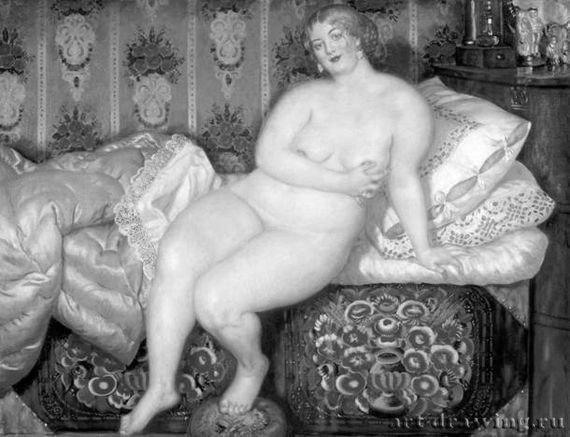
Boris Kustodiev painted this picture in 1915. A plump Russian beauty, a famous theater actress of that time, agreed to pose for the artist. In the center of the picture is a real Russian beauty in body. She is full of strength and energy, her body radiates health, and her delicate white skin is slightly shaded by the bluish white sheet.
It is important to pay attention to the girl’s pose; she is in no way depraved, but on the contrary, even chaste. The heroine of the picture boldly watches the artist’s work and does not feel embarrassed. Right hand she covers her magnificent breasts; on the ring finger of this hand the artist depicted a precious ring.
What is remarkable about this painting is the use of bright, rich colors. The picture is literally replete with a riot of colors used. It is impossible not to note the meticulousness with which the author drew out the details of the interior of the room. Behind the girl there is very beautiful blue wallpaper, on which a very precise and beautiful symmetrical pattern is applied, namely a bright red bouquet of roses.
Echoing the scarlet color of the young beauty’s lips and her bright blue eyes. It is necessary to note the ruddy complexion and fairly regular facial features. Long hair with a golden tint is tied back in an elegant bun, and the incredible beauty of her face is emphasized by precious earrings.
It is worth paying attention to the satin blanket. With what amazing precision the artist managed to translate its magnificent texture and elegant lace into the picture. It seems as if the young lady just pushed him away with her magnificent legs and is about to get up from her soft bed. What an abundance of colors the author uses to depict flowers on the bed. Bright red, blue and green shades fit perfectly together.
5 Description of the painting “Merchantwomen” — Kustodiev Boris Mikhailovich 25.01.2016 10:22
Description of the painting by Boris Kustodiev: Merchants.

Kustodiev turned to the image of ordinary women more than once. He was attracted as if by a magnet to enterprising women who were breathing health. Therefore, the artist’s collection contains a decent number of paintings on this topic. Among the entire array of paintings, the painting “Merchants’ Women” stands out qualitatively, where Kustodiev tried to convey the atmosphere of a medieval market. The canvas appeared in 1912 and immediately received a positive assessment from society.
In the center of the picture there are four magnificent ladies standing and talking about something. It seems that they are solving some important issues or discussing something. Moreover, one of them, the one in the yellow dress, demonstrates her disinterest in the conversation - her attention is attracted by a kind fellow standing somewhere in the distance. A coquette's smile is clearly visible on the young girl's face.
Three women, clearly older, are discussing important matters. Their clothes and hairstyles indicate that they have been married for a long time. It is worth noting that the artist tried to accurately convey the fashion of those times, and from the picture one can establish the century that Kustodiev is talking about.
In the background, the artist did not miss a single detail. The picture harmoniously combines various dishes, random passers-by, and even an absurdly hanging clock in the window of one of the shops. Even such an inconspicuous element as grass growing through a stone road did not hide from the artist’s gaze.
The canvas takes the art connoisseur back to the Middle Ages, to the famous fairs that gathered in big cities - Kharkov, Novgorod and Kyiv. The picture is simply imbued with the spirit of this era. The artist deserves special praise for his skillful use of colors; each element complements the other and forms a complete picture. In a word, not a picture, but a sight for sore eyes.
6 Description of the painting “Bathing” — Kustodiev Boris Mikhailovich 25.01.2016 10:38
Description of the painting by Boris Kustodiev: Bathing.
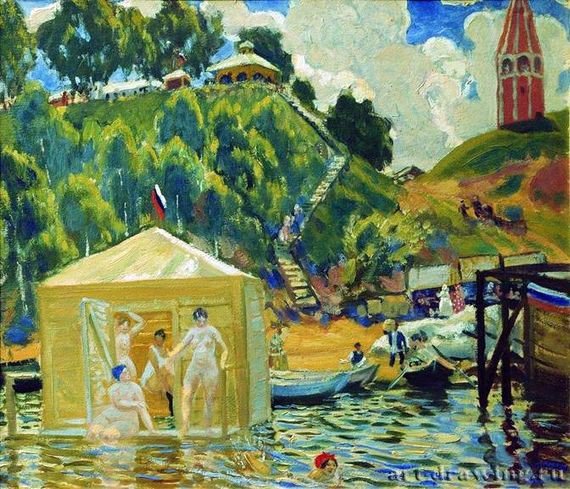
An amazing painting by Boris Kustodiev, a famous master of painting, “Bathing”, painted in oil on plywood in 1912.
The wide range of colors of the painting and color saturation perfectly show the painter’s handwriting. A bright sunny day is depicted truly “in the Kustodi style.” The viewer's gaze reveals the blueness of the sky, the sparkle of water shimmering in the sun, and a green slope with young birch trees. A bright yellow bathhouse stands out against this background. And all these details emphasize the beauty of a warm summer day.
With great tenderness and delicacy, the author of the work painted the images of bathers. He does not detail the figures of the women who are bathing, but depicts the female silhouettes as a little blurry. He does this schematically, taking the viewers’ eyes away from the swimming place itself, focusing on the beauty of the brightly colorful, artsy nature.
And everyday life goes on around them: boatmen offer people transportation services on the surface of the water; near the slope a loaded cart rises up the road. To the right you can see a church painted red on a hill.
Festive Summer mood The artist emphasized the bathers with the image of the Russian flag. The painter captured the tricolor in the painting twice. A white-blue-red canvas can be seen on the bathhouse and on the side of a huge boat.
Women bathers enjoy the warm sun, the smooth surface of the river, they talk among themselves, obviously about the most ordinary things, because measured life flows around them and it is a blessed time.
The brightness of Kustodiev’s colors fills the soul of contemplators with joy and delight.
There is too much of everything on the canvas - the background of the picture is too brightly colorful, which leaves almost no air space, the trees are too green, the waves are too prominent, there is too much saturation.
Gradually, the element of irony and theatricality grows in the composition of the paintings. The feeling of idyll, unreality, filled with nostalgia and sadness is becoming stronger and stronger.
We see the merchant's wife and the brownie standing in front of her. The furnace is open. Fire at night creates a special impression. It makes a characteristic crackling sound and casts bizarre shadows. Such sounds can not only pacify, but also cause unaccountable anxiety. There is a carpet in front of the open stove door. This situation is extremely dangerous, as sparks may accidentally fall on it.
Kustodiev’s merchant’s wife is absolutely defenseless. She sleeps in a completely open position. Her bed is a chest with a down blanket and feather beds. Featherbeds are allegorically associated with the clouds of paradise. According to official religion, the brownie belongs specifically to the dark world. But before, he was considered the real owner of the house, who protected him from everything evil. The presence of a brownie was considered the norm. +4 Description of the painting “Haymaking” — Kustodiev Boris Mikhailovich 25.01.2016 10:44
Description of the painting by Boris Kustodiev: Haymaking.
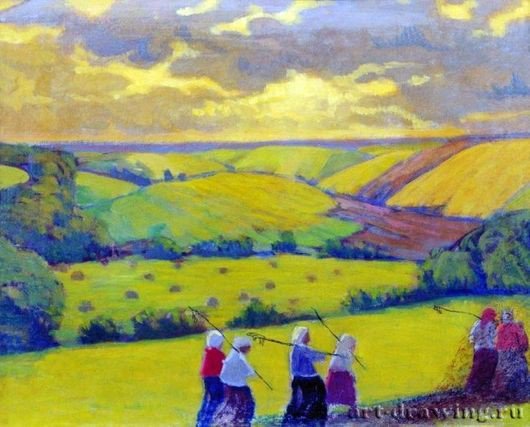
The master depicts in the picture one of the summer evenings. On the canvas you can see the girls returning home after mowing. Summer is the most important time of the year for these people, because wintering directly depends on how well the work is done in haymaking in the summer.
Women are visible in the picture, some of them are clearly older, but this is not accidental. They go home and apparently do not talk to each other, this is due to the fact that work in the field is very hard and exhausting, and takes all the strength.
The artist paints twilight with a slightly bluish tint, because of this, everything in the area, including the women’s clothes, also takes on a bluish tint. In the background you can see simply huge expanses of fields and woodlands, meadows and hills. Everything around, including the sky, has a yellowish-blue tint, in places gradually turning into green. Such shades were not chosen by chance and looking at the canvas involuntarily brings to mind various thoughts about relaxation after a hard working day, under the exhaustingly scorching sun from above.
The whole atmosphere conveys the mood of fatigue, twilight, and the approaching evening. Kustodiev was very drawn to simple motifs of everyday life, ordinary people, therefore, he has many similar works, but they all have a common idea of originality.
The picture quite clearly conveys the play of light and shadow in the setting of twilight, this can be seen in the bushes and trees, which not only themselves have all shades of green, but also taking into account the onset of evening. Thanks to this resonance of colors, the canvas very accurately conveys the exact mood that the artist put into it when he painted it.
The viewer is completely immersed in the atmosphere of what is happening, thanks to which the picture is able to literally captivate the eye and think about what is happening for a long time.
And if you listen closely, you can hear, it seems, a romance coming from somewhere, which brings to mind Ostrovsky’s “Dowry.” Larisa with Paratov and the rest are about to appear... In general, the picture of provincial life, captured from the height of the second floor, produces a truly peaceful, strangely harmonious impression.
It’s not for nothing that Kustodiev was nicknamed “the dreamer of everyday life.” Like Gogol, through detail he strives to depict the character of the Russian nation, to convey the longing for a bygone Rus' with its leisurely patriarchal way of life on the eve of the events of the twentieth century. Having once gone on vacation to the Kostroma province, he first saw a fair, which struck him with its brightness and variety of interesting people to the core. From here follows the artist’s latent desire to capture the festive side of people’s life - perhaps not without the influence of the creator of “Evenings on a Farm near Dikanka.”
Still, Kustodiev is a modern artist by nature +3 Description of the painting “Autumn” — Kustodiev Boris Mikhailovich 25.01.2016 11:00
Description of the painting by Boris Kustodiev: Autumn.

Boris Mikhailovich Kustodiev is a Russian painter of the late 19th and first quarter of the 20th century. The painting “Autumn” is part of a series of three paintings entitled: “Autumn in the Province” and “Autumn over the City”. The canvas was created in 1924, today it is in one of the private collections, as a result of which it is not available for free viewing.
In the painting, the artist depicts autumn in all its colors, as it was seen by the pampered residents of large manorial estates, one of which is visible in the background of the canvas.
The foreground of the painting is decorated with an image of a woman in a bright fluffy dress, to match the surrounding light and shimmering nature with all the colors of the rainbow. The woman apparently went for a walk and met her friend, who came out to admire the warm autumn day on the porch of his house. The landscape is typically rustic, chickens and roosters are running around, a peasant is trying to calm down an angry white horse, the road runs straight to a shining blue river. There is bustle and fun everywhere, the surrounding nature and people are enjoying the warm autumn day.
Above the big manor house the crowns of bright red trees rise, some of them still retain their summer greenery, or their original yellowness, while others are ready to appear in all their glory before anyone who is planning to walk along a village street on a warm autumn day. Behind the houses and trees you can see the bell tower; just like the tops of the trees, it goes up and rises to the blue and clear sky. Description of the painting “Winter landscape” —
Kustodiev Boris Mikhailovich
25.01.2016 11:01
Description of the painting by Boris Kustodiev: Winter landscape.
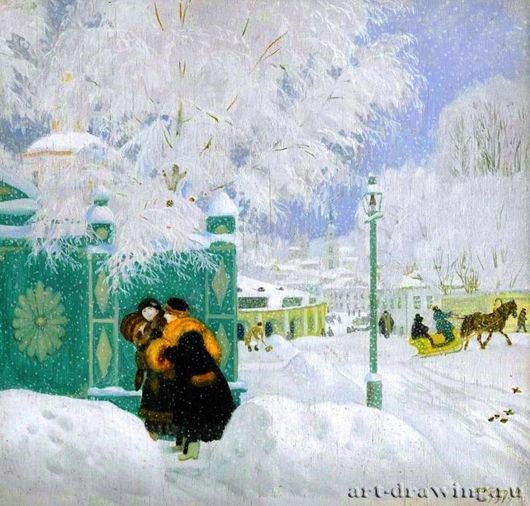
The painting was painted in 1919.
Many artists loved such a genre of painting as landscape. It was in nature that artists found a direct reflection of their own feelings and innermost thoughts.
The background of many of Kustodiev’s works was the winter landscape. We see festivities. The artist himself seems to be on a height from which he sees everything that is happening. This allowed the painter to capture the entire landscape as a whole.
The painting depicts a clear frosty day. The landscape is so colorful that you can’t help but create a feeling of a joyful holiday. Kustodiev made the most of bright colors to convey the true beauty of winter. All snowdrifts are as prominent as possible. Trees covered with frost resemble festive fireworks.
At first glance, it may seem that nature is not so real. The colors are too bright and unnatural. But this picture is all Kustodiev. This is how he saw Russian rural nature. There are so many rich colors here that it creates a joyful mood. It seems that the whole picture is simply permeated with celebration and fun. The painter managed to masterfully convey this through. Seemingly insignificant details. Everything here is important, every small detail is necessary for the overall composition and holistic perception.
In the foreground we see two figures in elegant clothes. They are talking enthusiastically about something. Their faces are not described in detail, and this is not necessary. The artist’s goal is to convey an unusually joyful feeling of cheerful winter day, which is tangible in all the details of this picture.
The dynamics of the entire plot of the picture are given by the sleigh that races in the background. They are important element many paintings by the artist. It conveys movement. We feel that the picture is not static. It seems that we are about to hear the ringing of a bell and hear cheerful laughter.
In its composition, Kustodiev’s work resembles popular prints.
3
Description of the painting by Boris Kustodiev “Bolshevik” — Kustodiev Boris Mikhailovich 25.01.2016 11:02Description of the painting by Boris Kustodiev: Bolshevik.
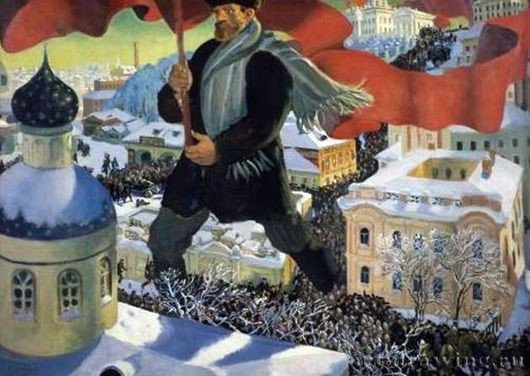
There is probably no person who does not know this picture. The picture was painted under the impression of the October Revolution. The motive for painting the painting was the artist’s desire to convey to the viewer the image of the hero of that time - the Bolshevik.
In this painting, the character was painted for the first time by the artist in a manner completely atypical for him. Previously, Kustodiev had never portrayed unrealistic characters. In this case, there is a grotesque increase in the role of the Bolshevik figure.
A huge man in a hat with earflaps and a padded jacket walks through the streets of the capital with a huge waving flag of the country of the Soviets in his hands. The flag is huge, it is a symbol of the fire of revolution. And everywhere there are people, people, people... They are armed, they are determined to fight for their interests. The giant's face is filled with no less determination. He is a simple Russian man, an ordinary worker. He is the same as everyone else who took to the streets. He walks confidently, clearly understanding where his path leads.
There is only one obstacle in front of him - the church. It is she who symbolizes imperial power, its last stronghold. But she will not stop the giant either - he will take a decisive step and cross the church with ease. The revolutionary movement is striking in its mass and strength.
The giant, as it were, personifies the leader of the crowd - he shows people the right path, leads them to a new life. The Bolshevik shows them that there are no more barriers and fear, only a bright future awaits the Soviet people.
The picture is full of illusory ideas about the very meaning of the revolution and its significance for the people. This is due, first of all, to an incorrect understanding of these problems by the author of the film himself. Kustodiev was very grateful to the Bolsheviks for their help in his work and appreciation of his talent. His gratitude largely formed the basis of this painting.
The viewer cannot see the faces of any visitor to the fair. All visitors to the fair put on their best festive clothes - how could it be otherwise, because fairs were truly a festive event for them. Women have elegant dresses, patterned scarves, men have new bast shoes and beautiful caftans.
Two elderly men in the foreground are discussing something furiously. Most likely, they are talking about previous fairs. Children, out of habit, look at sweets and toys. There is a girl clutching a new doll in her hand, and a boy chewing sugar.
Most women choose and try on beautiful patterned scarves. Two young ladies are discussing the goods on the counter among themselves.
On the other side of the canvas, the newly-minted indicators select things suitable for the household - rakes, shovels and wooden buckets. A woman tries to bargain with a rake seller.
Young guys choose musical instruments. Their choice fell on the harmonica. They are in no hurry to buy it; first they try the sound of a new musical instrument.
There is vibrant life everywhere. All visitors to the fair are lively and cheerful, talking, discussing everything that is happening around them, discussing the brought goods, consulting, and bargaining. — Kustodiev Boris Mikhailovich 25.01.2016 11:12
Description of the painting by Boris Kustodiev: Blue House.
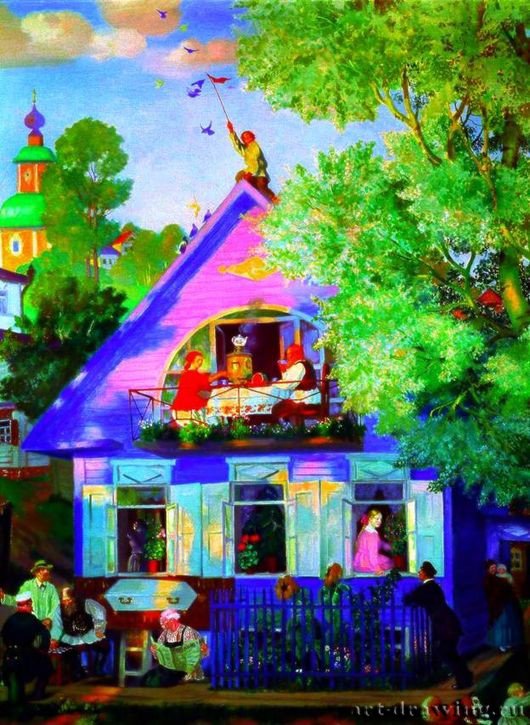
The canvas was painted in 1920. For an artist, a house is not just an architectural structure that must be completed while maintaining proportions and clear lines - it is life itself, gushing out from all the doors and windows. Everything is exactly the same in Kustodiev’s film “The Blue House”.
A house painted in a pure heavenly color and the people it unites bring to one place so that they can feel their integrity, not only with this house, but also with each other.
Home is the place where human destiny begins, which, bringing thousands of trials, will return him here to see him off on his final journey. Understanding this, the artist depicts not just a house, but the whole human life. Therefore, researchers of the painting believe that understanding it is possible only if they begin to examine it in parts, according to the planned arrangement of the characters.
So, in the foreground are shown simple people, different professions, playing chess, as if playing out the game of their lives, which will still end in the undertaker's shop, located in the basement of the house. The Undertaker is the end of the journey, but its beginning can be seen at the very bottom of the picture, where small children are placed almost invisibly, busy playing with a dog.
Next, the artist depicts a couple in love, showing that life goes on, and as a result, around the corner of the house a woman with a baby is shown, undoubtedly symbolically reminiscent of the Mother of God with Jesus in her arms.
At the very top, on the balcony, the owners of the house are having tea, gathered around the samovar. Everything is perfect and beautiful, the table is richly set, the flower pots are fragrant, but these people will also come to the undertaker’s shop.
On the roof, a teenager scares away pigeons, he is taller than everyone else, since he is not familiar with the dreams of a couple in love, or the worries of his mother, or even the problems of people gathered for tea and games, he is completely carefree, and therefore ideal. This boy represents the youth and strength of the Russian people, who do not lose heart in the face of any adversity.
The picture is filled with light and happiness, everything here is harmonious and joyful, and what else is necessary for the human soul.
It is worth noting, of course, that there are actually a lot of paintings with merchant women, but the most successful, and unique in its harmony and completeness of the image, is undoubtedly “Tea Party”. Notice how everything in this picture, mainly due to its image alone, harmoniously intersects with one another.
On the balcony, behind dining table, sits a dressed up, simply huge, corpulent merchant’s wife, with a table bursting with treats. In this picture, the image of the merchant's wife is completely played out, and carries a great semantic load into the picture. Small little nuances that give integrity to the image and completeness of the picture.
Like, for example, a cat that rubs against its owner’s big shoulder, but she is unshakable. Behind her large back is a beautiful image of the city, with churches and shopping arcades. And this, unthinkable for the common man of that time, is a still life of all kinds of baked goods, tea is poured into beautiful porcelain, and in the center of the table there is a handsome samovar and, oddly enough, a watermelon.
At the time of painting, there was terrible famine and devastation, so such a picture is simply a cry from the heart, it is a dream that he embodied on canvas. Kustodiev tried to show the whole essence of the merchant's wife, with a certain amount of irony. All his paintings are distinguished by cheerfulness and a share of healthy optimism. An excellent attempt to ridicule and show us one day from a thoughtless, but well-fed, sometimes even too full, life.
There is nothing superfluous, the whole picture is described quite accurately, a good combination of colors and two plans, foreground and background, respectively. The accessibility and ease of understanding of this painting is amazing; the artist did his best. | | |
